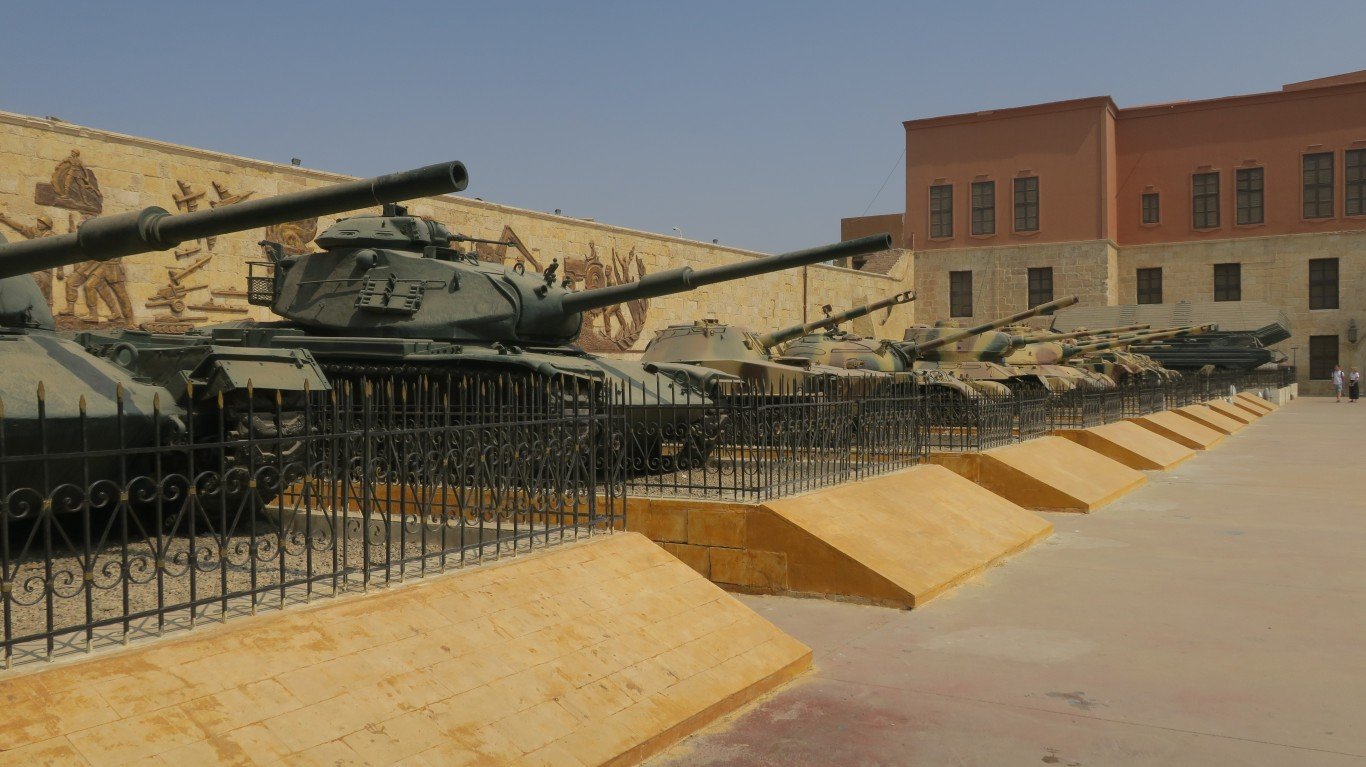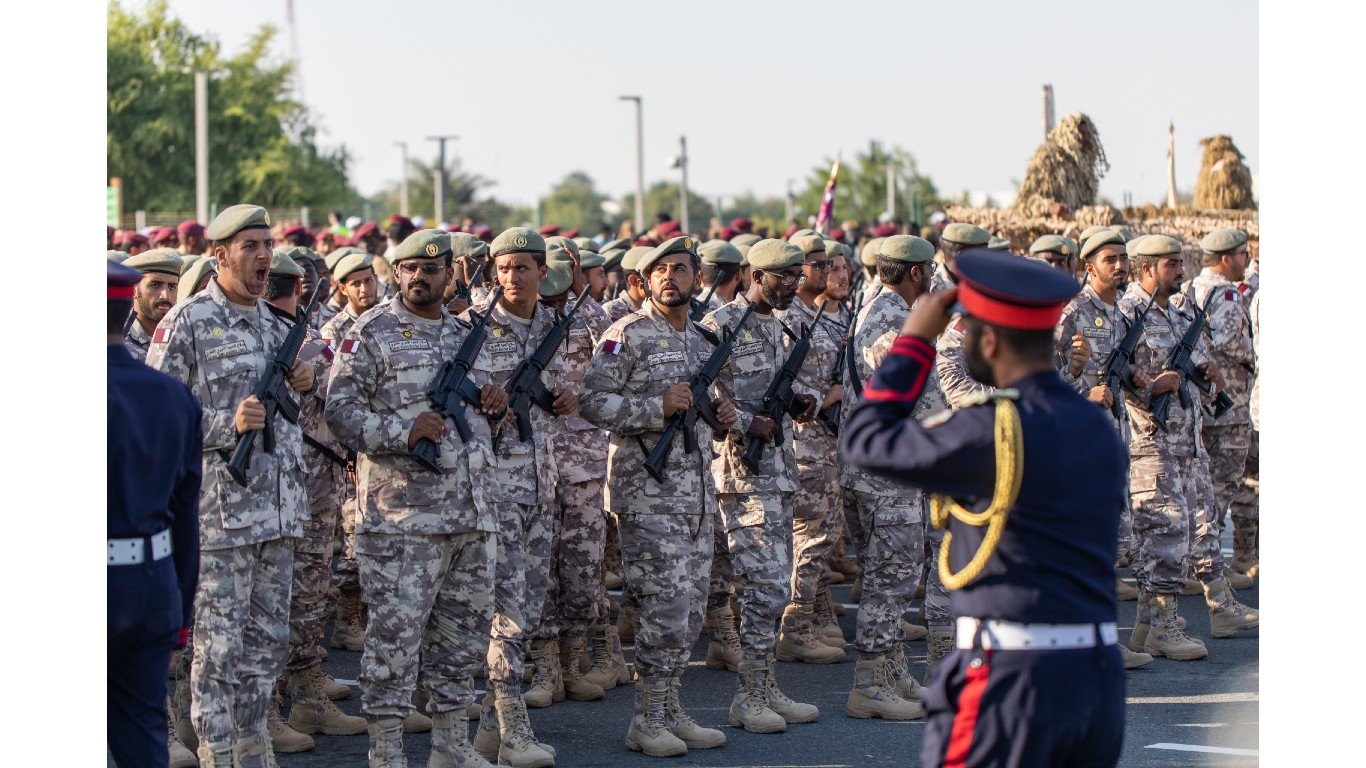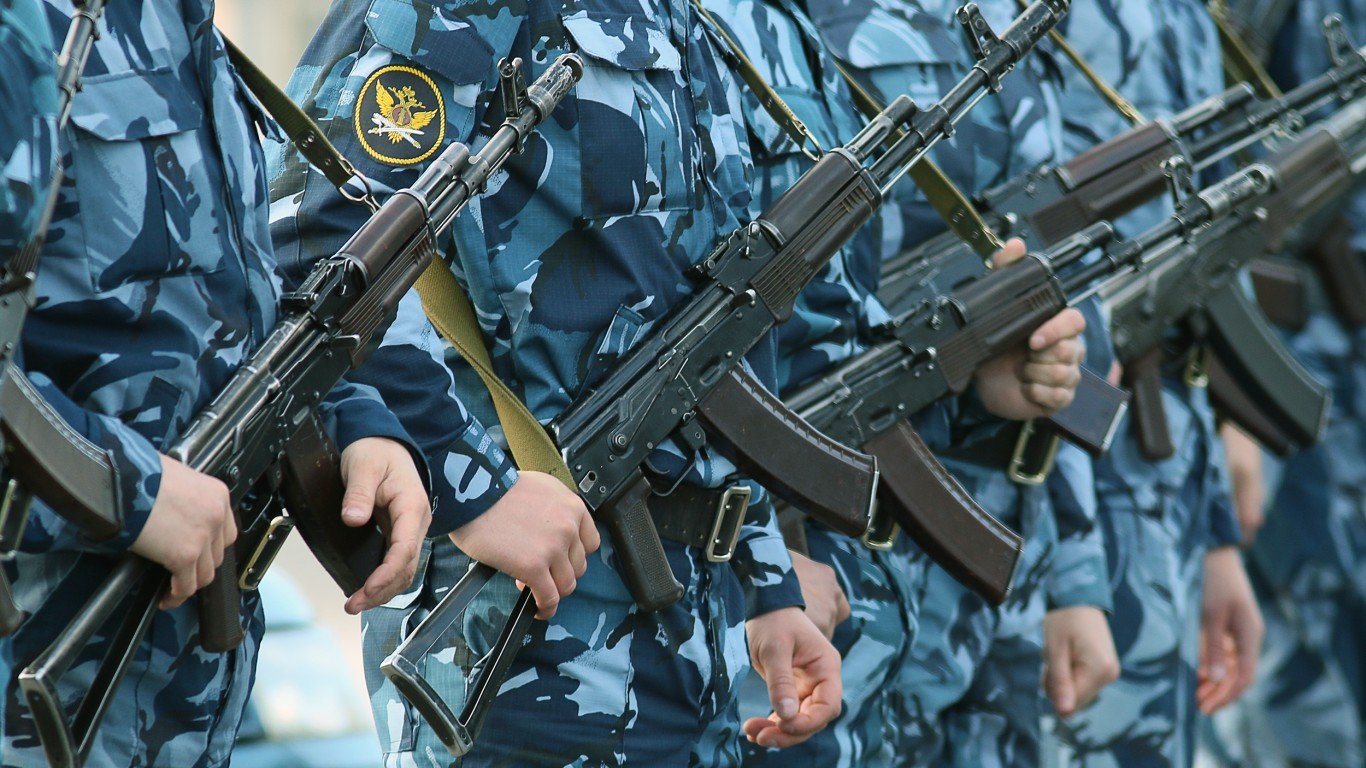

European nations increased arms imports by 47% in 2018-2022 compared to the previous five-year period. This increase, part of the findings of a report released today by the Stockholm International Peace Research Institute, is likely at least in part a result of Russia’s invasion of Ukraine and the ongoing war being fought there. The war-torn nation has received tens of billions in aid from the United States and other countries, and Ukraine’s neighbors have been arming themselves as well.
To determine the countries importing the most weapons, 24/7 Wall St. reviewed data from the Trends in International Arms Transfers, 2022 report by SIPRI. Countries are ranked by their share of imported arms out of global import volume from 2018 to 2022. Because volume can fluctuate greatly from year to year, SIPRI tracks arms transfers in five-year periods. Supplemental data on annual military expenditure in current U.S. dollars and military spending as a share of GDP are also from SIPRI and are for 2021, the most recent year for which data is available.
For the most recent five-year period, Ukraine is tied with Norway for the 14th largest importer of weapons, with 2% of the world’s imports from 2018 to 2022. Unsurprisingly, that figure represents a substantial increase from the previous five-year period. Between 2013 and 2017, Ukraine accounted for less than 0.05% of the world’s weapons imports, and arms exports to the country increased a staggering 8,631% between those two periods.
Ukraine’s largest supplier is the United States, which just this month pledged its 33rd weapons aid package to the country, bringing the total it has supplied the beleaguered nation to more than $30 billion. In fact, the U.S. is the single largest supplier of arms for 19 of the 40 largest global weapons importers, and is among the top three sellers for 27. Another major supplier of arms to Ukraine is Poland, a nation that, like many of Ukraine’s European neighbors, has a keen vested interest in the outcome of the war. (These are the countries buying the most weapons from the U.S. government.)
A new entry to the list this year is not a country at all, but the North Atlantic Treaty Organization, which accounted for 0.7% of global arms imports in the most recent period. Like Ukraine, that figure is up from less than 0.05% just five years ago. This does not include the additional imports of NATO member states, of which both the United States and Poland are members, but the organization itself. (These are all the NATO members ranked by military power.)
Click here to see the nations importing the most weapons and their biggest suppliers.
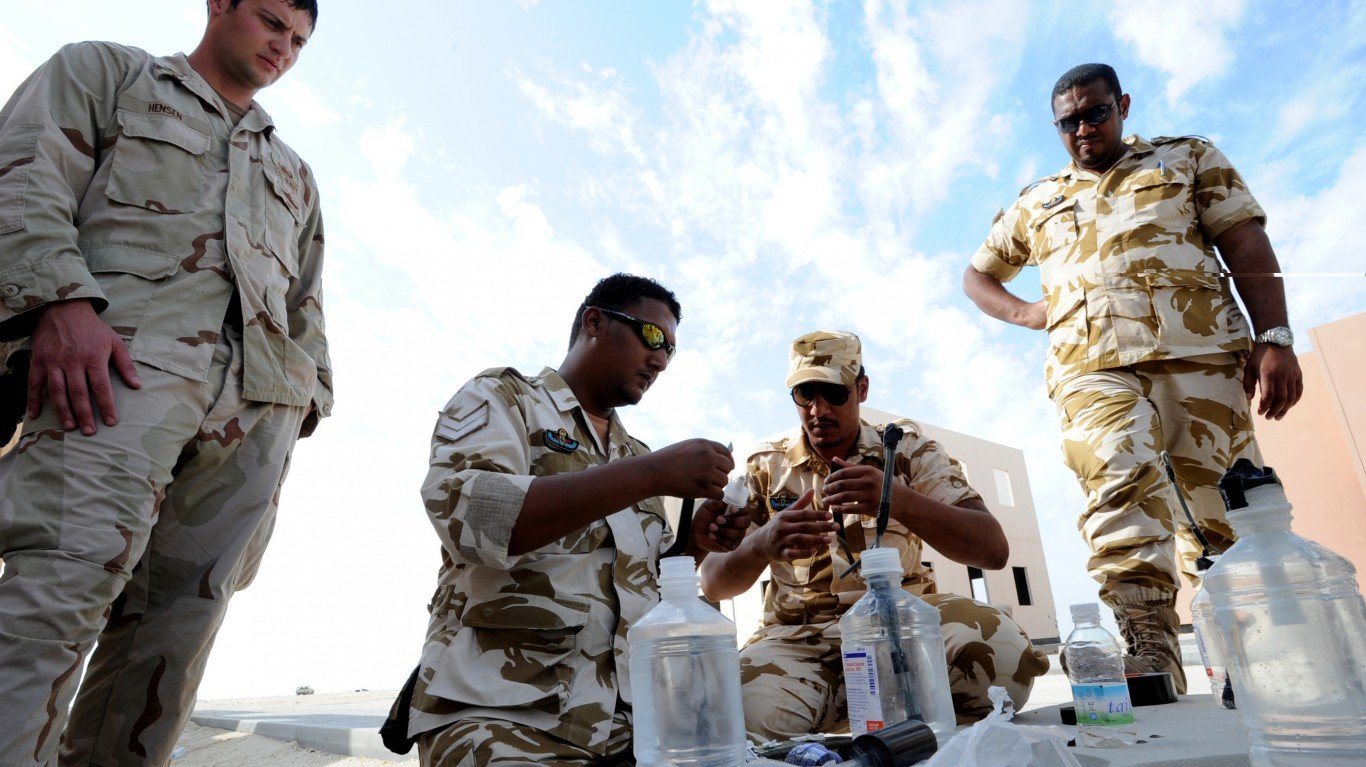
40. Bahrain
> Share of global arms imports, 2018-2022: 0.5% — tied
> Share of global arms imports, 2013-2017: 0.1%
> Largest supplier: United States (83% of Bahrain imports)
> 2nd largest supplier: United Kingdom (7% of Bahrain imports)
> 3rd largest supplier: Italy (4.1% of Bahrain imports)
> Annual military expenditure (2021): $1.4 billion — #64 highest of 154
> Annual military expenditure as pct. of GDP (2021): 3.6% — #15 highest of 150
[in-text-ad]

39. Jordan
> Share of global arms imports, 2018-2022: 0.5% — tied
> Share of global arms imports, 2013-2017: 0.8%
> Largest supplier: United States (40% of Jordan imports)
> 2nd largest supplier: United Arab Emirates (20% of Jordan imports)
> 3rd largest supplier: Russia (17% of Jordan imports)
> Annual military expenditure (2021): $2.2 billion — #58 highest of 154
> Annual military expenditure as pct. of GDP (2021): 5% — #7 highest of 150

38. Chile
> Share of global arms imports, 2018-2022: 0.5% — tied
> Share of global arms imports, 2013-2017: 0.3%
> Largest supplier: United Kingdom (38% of Chile imports)
> 2nd largest supplier: Australia (36% of Chile imports)
> 3rd largest supplier: United States (10% of Chile imports)
> Annual military expenditure (2021): $6.2 billion — #34 highest of 154
> Annual military expenditure as pct. of GDP (2021): 2% — #51 highest of 150
37. Serbia
> Share of global arms imports, 2018-2022: 0.5% — tied
> Share of global arms imports, 2013-2017: 0.1%
> Largest supplier: China (43% of Serbia imports)
> 2nd largest supplier: Russia (31% of Serbia imports)
> 3rd largest supplier: Belarus (20% of Serbia imports)
> Annual military expenditure (2021): $1.3 billion — #65 highest of 154
> Annual military expenditure as pct. of GDP (2021): 2.1% — #44 highest of 150
[in-text-ad-2]
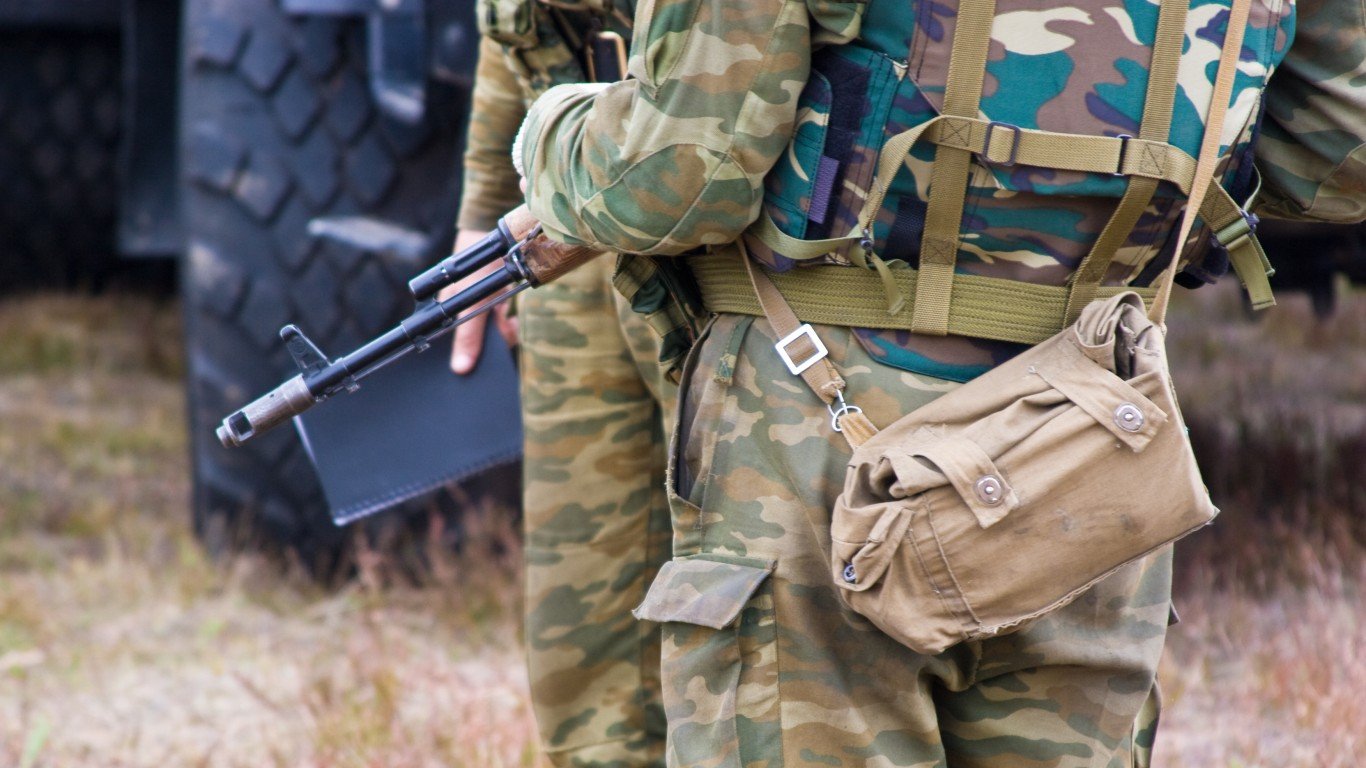
36. Belarus
> Share of global arms imports, 2018-2022: 0.6% — tied
> Share of global arms imports, 2013-2017: 0.3%
> Largest supplier: Russia (100% of Belarus imports)
> 2nd largest supplier: China (0.1% of Belarus imports)
> 3rd largest supplier: N/A
> Annual military expenditure (2021): $762.8 million — #76 highest of 154
> Annual military expenditure as pct. of GDP (2021): 1.2% — #103 highest of 150
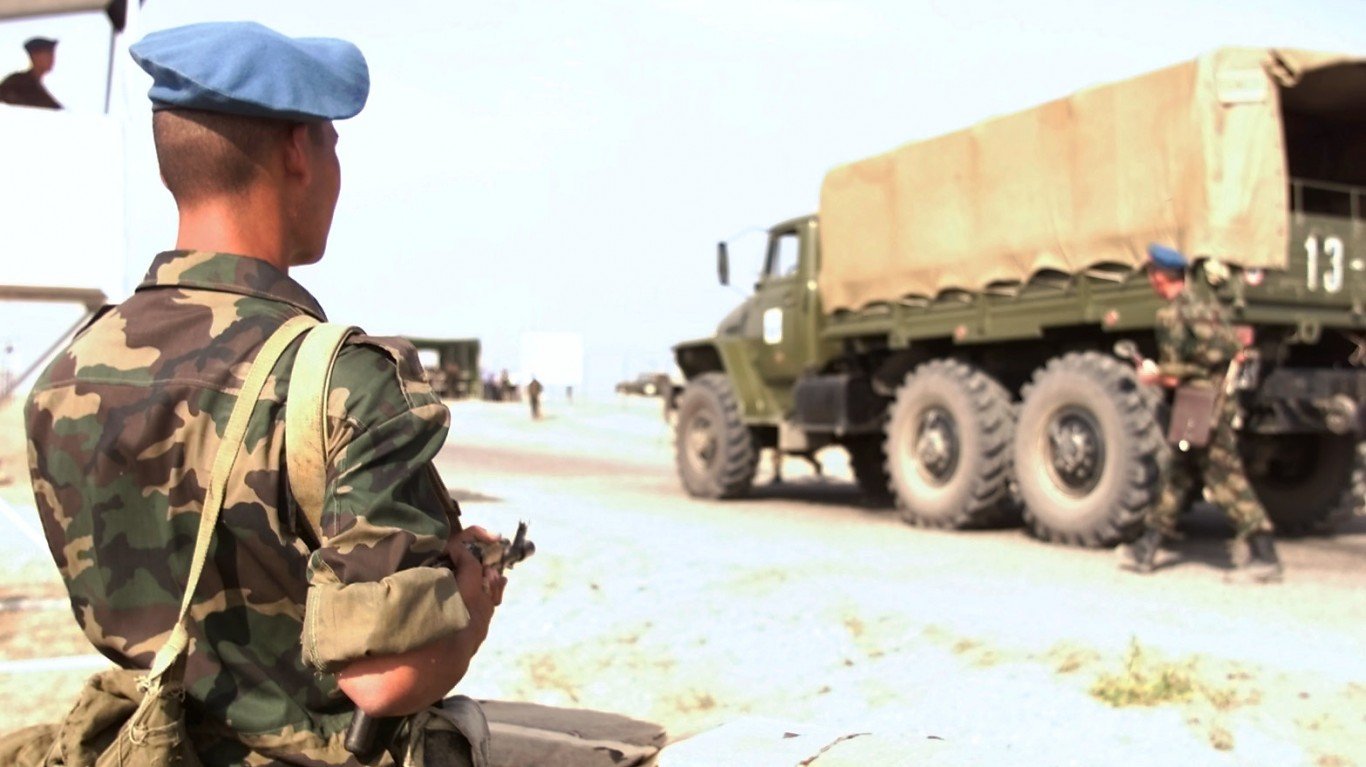
35. Kazakhstan
> Share of global arms imports, 2018-2022: 0.6% — tied
> Share of global arms imports, 2013-2017: 0.8%
> Largest supplier: Russia (94% of Kazakhstan imports)
> 2nd largest supplier: China (2.6% of Kazakhstan imports)
> 3rd largest supplier: South Africa (1.8% of Kazakhstan imports)
> Annual military expenditure (2021): $1.6 billion — #62 highest of 154
> Annual military expenditure as pct. of GDP (2021): 0.9% — #125 highest of 150
[in-text-ad]

34. Greece
> Share of global arms imports, 2018-2022: 0.7% — tied
> Share of global arms imports, 2013-2017: 0.9%
> Largest supplier: France (48% of Greece imports)
> 2nd largest supplier: United States (29% of Greece imports)
> 3rd largest supplier: United Kingdom (12% of Greece imports)
> Annual military expenditure (2021): $8.1 billion — #30 highest of 154
> Annual military expenditure as pct. of GDP (2021): 3.9% — #13 highest of 150

33. Canada
> Share of global arms imports, 2018-2022: 0.7% — tied
> Share of global arms imports, 2013-2017: 1.1%
> Largest supplier: United States (32% of Canada imports)
> 2nd largest supplier: Australia (27% of Canada imports)
> 3rd largest supplier: Spain (15% of Canada imports)
> Annual military expenditure (2021): $26.4 billion — #13 highest of 154
> Annual military expenditure as pct. of GDP (2021): 1.3% — #92 highest of 150
32. Afghanistan
> Share of global arms imports, 2018-2022: 0.7% — tied
> Share of global arms imports, 2013-2017: 0.8%
> Largest supplier: United States (96% of Afghanistan imports)
> 2nd largest supplier: Brazil (2.6% of Afghanistan imports)
> 3rd largest supplier: Belarus (1.4% of Afghanistan imports)
> Annual military expenditure (2021): $278.3 million — #107 highest of 154
> Annual military expenditure as pct. of GDP (2021): N/A
[in-text-ad-2]
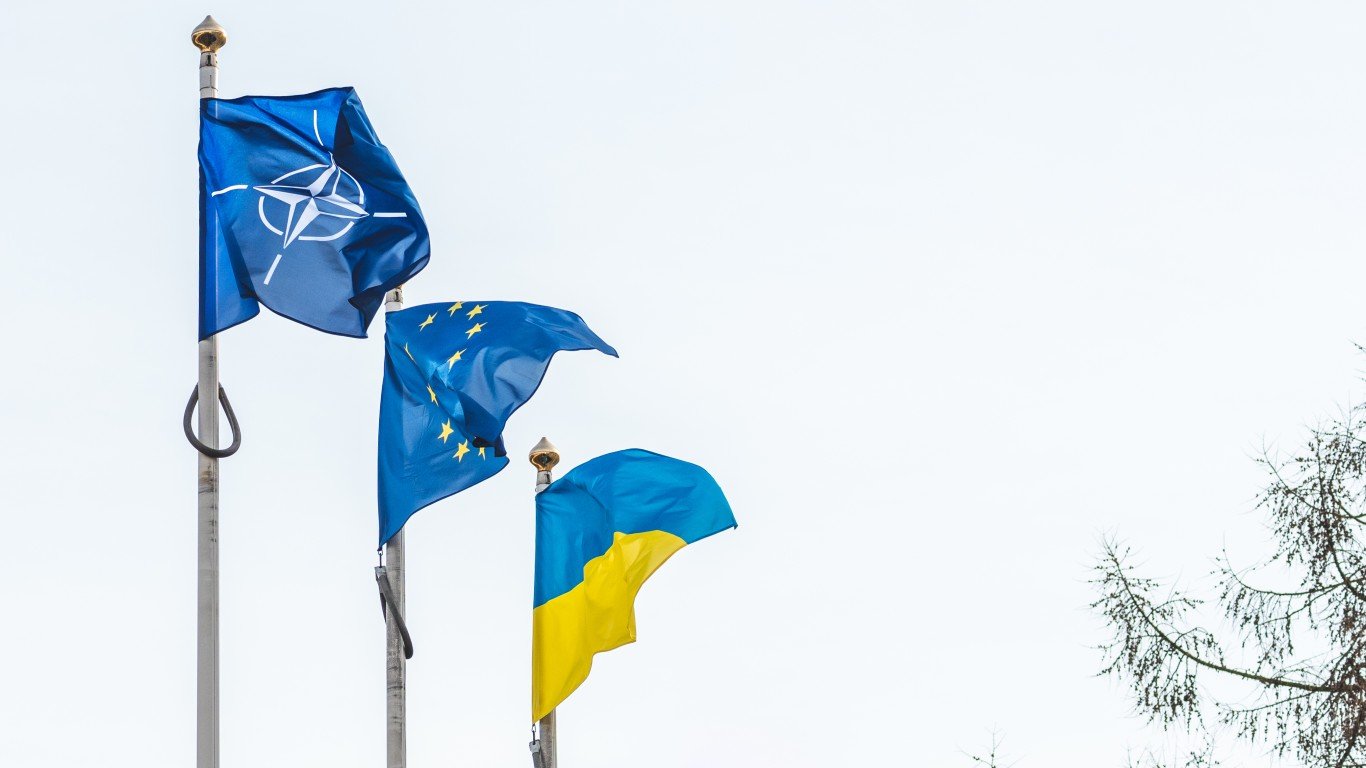
31. NATO
> Share of global arms imports, 2018-2022: 0.7% — tied
> Share of global arms imports, 2013-2017: <0.05%
> Largest supplier: France (66% of NATO imports)
> 2nd largest supplier: United States (18% of NATO imports)
> 3rd largest supplier: United Kingdom (15% of NATO imports)
> Annual military expenditure (2021): N/A
> Annual military expenditure as pct. of GDP (2021): N/A

30. Myanmar
> Share of global arms imports, 2018-2022: 0.8% — tied
> Share of global arms imports, 2013-2017: 0.8%
> Largest supplier: Russia (42% of Myanmar imports)
> 2nd largest supplier: China (29% of Myanmar imports)
> 3rd largest supplier: India (14% of Myanmar imports)
> Annual military expenditure (2021): $2.1 billion — #59 highest of 154
> Annual military expenditure as pct. of GDP (2021): 3.3% — #18 highest of 150
[in-text-ad]
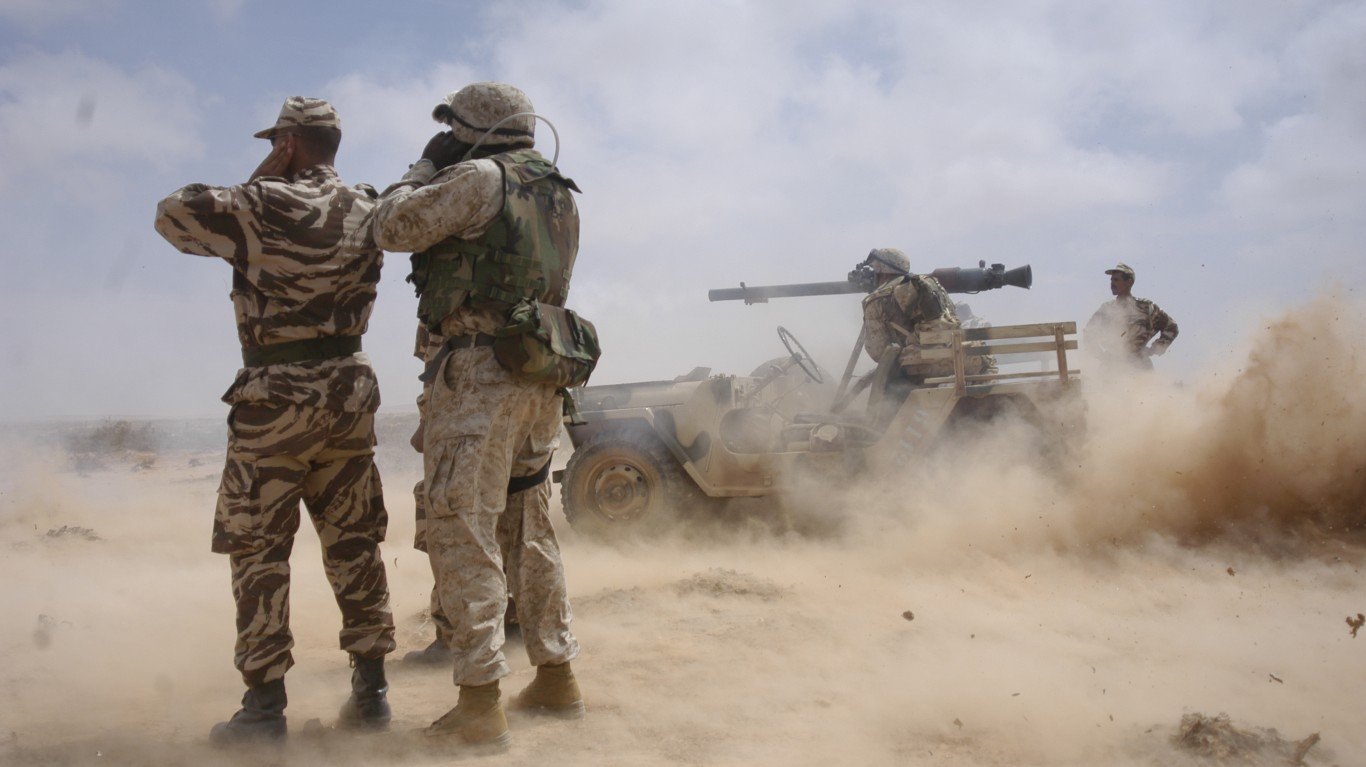
29. Morocco
> Share of global arms imports, 2018-2022: 0.8% — tied
> Share of global arms imports, 2013-2017: 1.1%
> Largest supplier: United States (76% of Morocco imports)
> 2nd largest supplier: France (15% of Morocco imports)
> 3rd largest supplier: China (6.8% of Morocco imports)
> Annual military expenditure (2021): $5.4 billion — #41 highest of 154
> Annual military expenditure as pct. of GDP (2021): 4.2% — #11 highest of 150
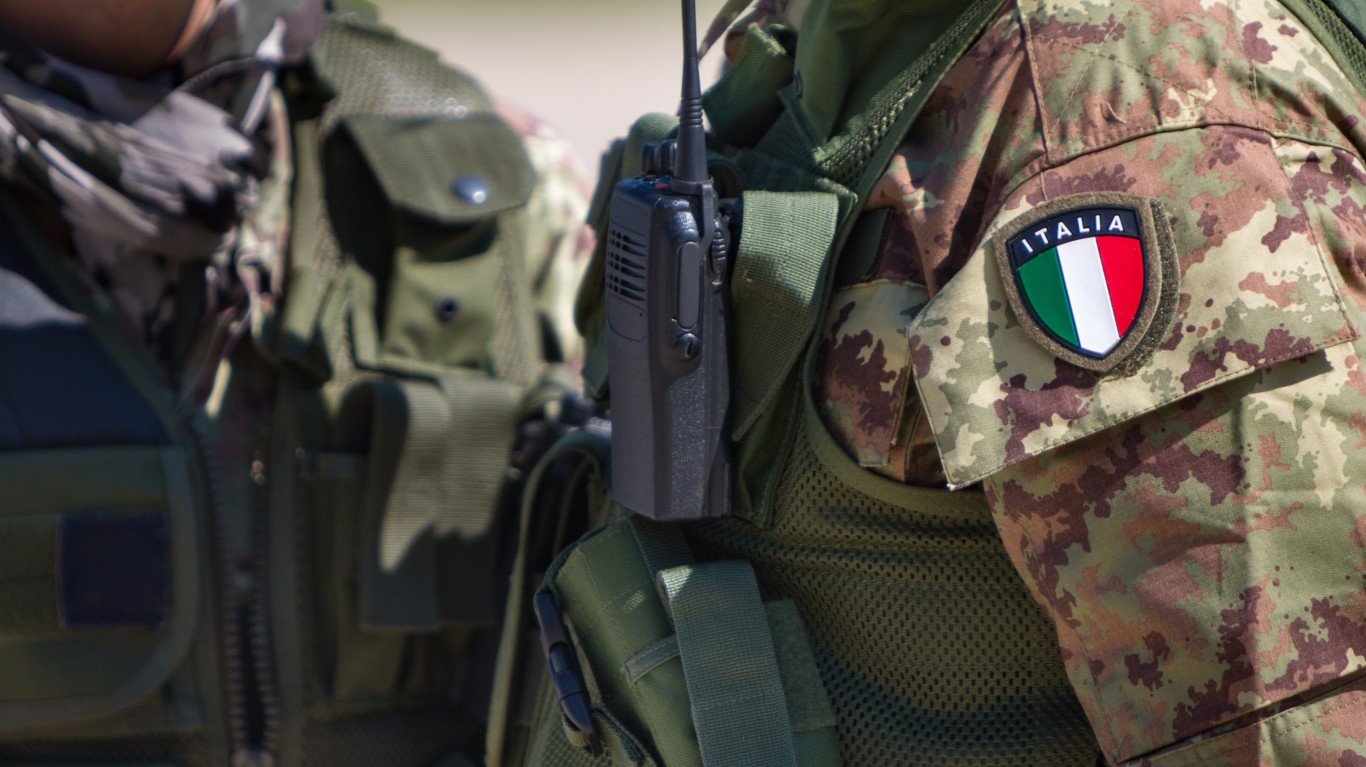
28. Italy
> Share of global arms imports, 2018-2022: 0.8% — tied
> Share of global arms imports, 2013-2017: 1.3%
> Largest supplier: United States (92% of Italy imports)
> 2nd largest supplier: Israel (4.4% of Italy imports)
> 3rd largest supplier: France (2% of Italy imports)
> Annual military expenditure (2021): $32.0 billion — #11 highest of 154
> Annual military expenditure as pct. of GDP (2021): 1.5% — #77 highest of 150
27. Vietnam
> Share of global arms imports, 2018-2022: 0.8% — tied
> Share of global arms imports, 2013-2017: 2.8%
> Largest supplier: Russia (55% of Vietnam imports)
> 2nd largest supplier: Israel (16% of Vietnam imports)
> 3rd largest supplier: Belarus (10% of Vietnam imports)
> Annual military expenditure (2021): N/A
> Annual military expenditure as pct. of GDP (2021): N/A
[in-text-ad-2]
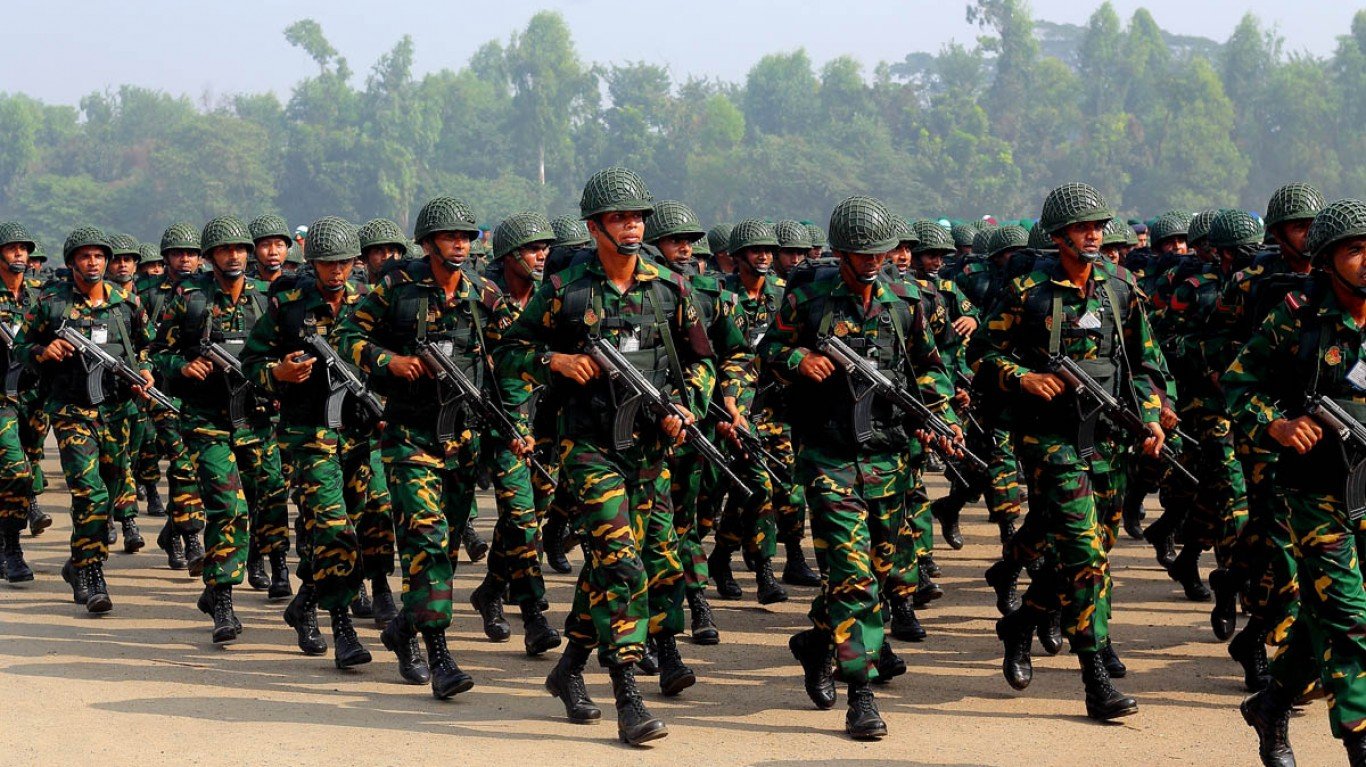
26. Bangladesh
> Share of global arms imports, 2018-2022: 0.8% — tied
> Share of global arms imports, 2013-2017: 1.6%
> Largest supplier: China (74% of Bangladesh imports)
> 2nd largest supplier: United Kingdom (5.8% of Bangladesh imports)
> 3rd largest supplier: Turkiye (4.5% of Bangladesh imports)
> Annual military expenditure (2021): $4.9 billion — #44 highest of 154
> Annual military expenditure as pct. of GDP (2021): 1.3% — #98 highest of 150
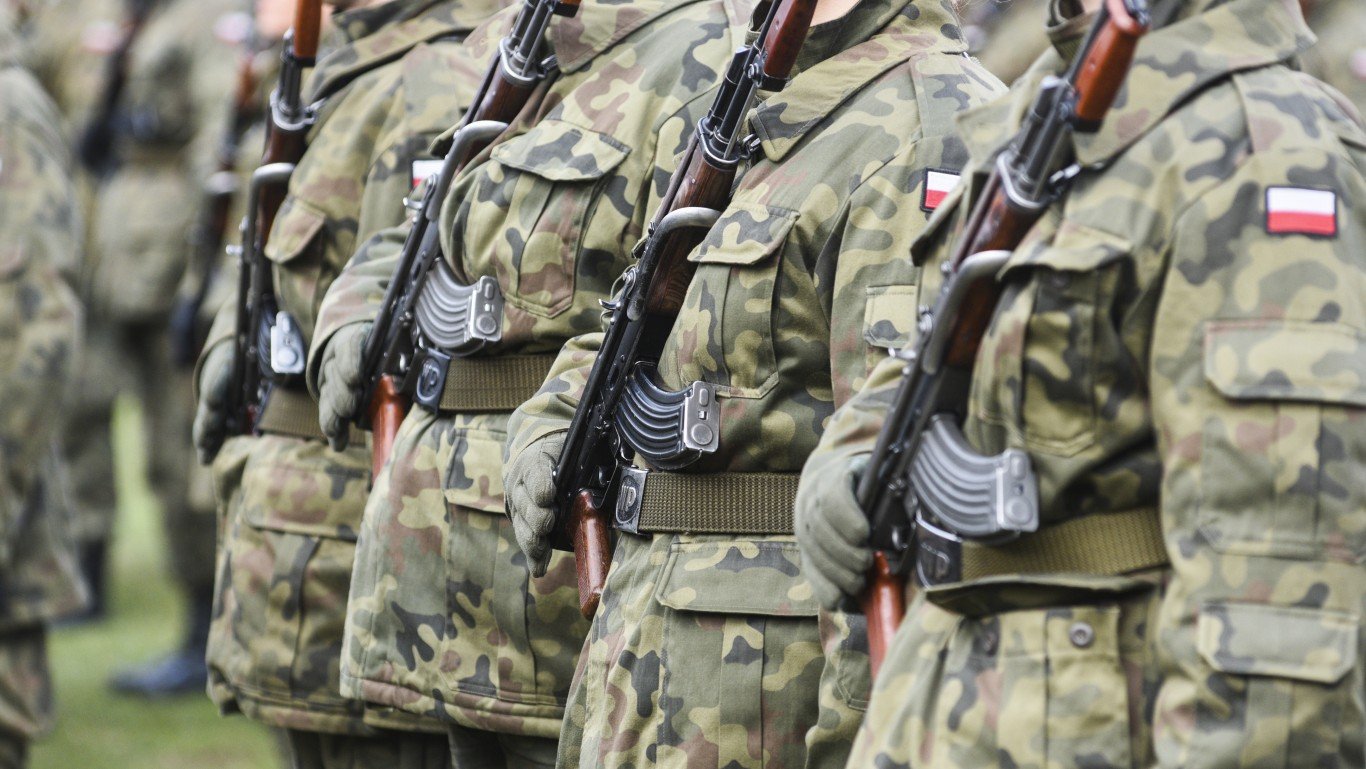
25. Poland
> Share of global arms imports, 2018-2022: 0.9% — tied
> Share of global arms imports, 2013-2017: 0.5%
> Largest supplier: United States (56% of Poland imports)
> 2nd largest supplier: South Korea (17% of Poland imports)
> 3rd largest supplier: Germany (6.5% of Poland imports)
> Annual military expenditure (2021): $13.7 billion — #20 highest of 154
> Annual military expenditure as pct. of GDP (2021): 2.1% — #43 highest of 150
[in-text-ad]
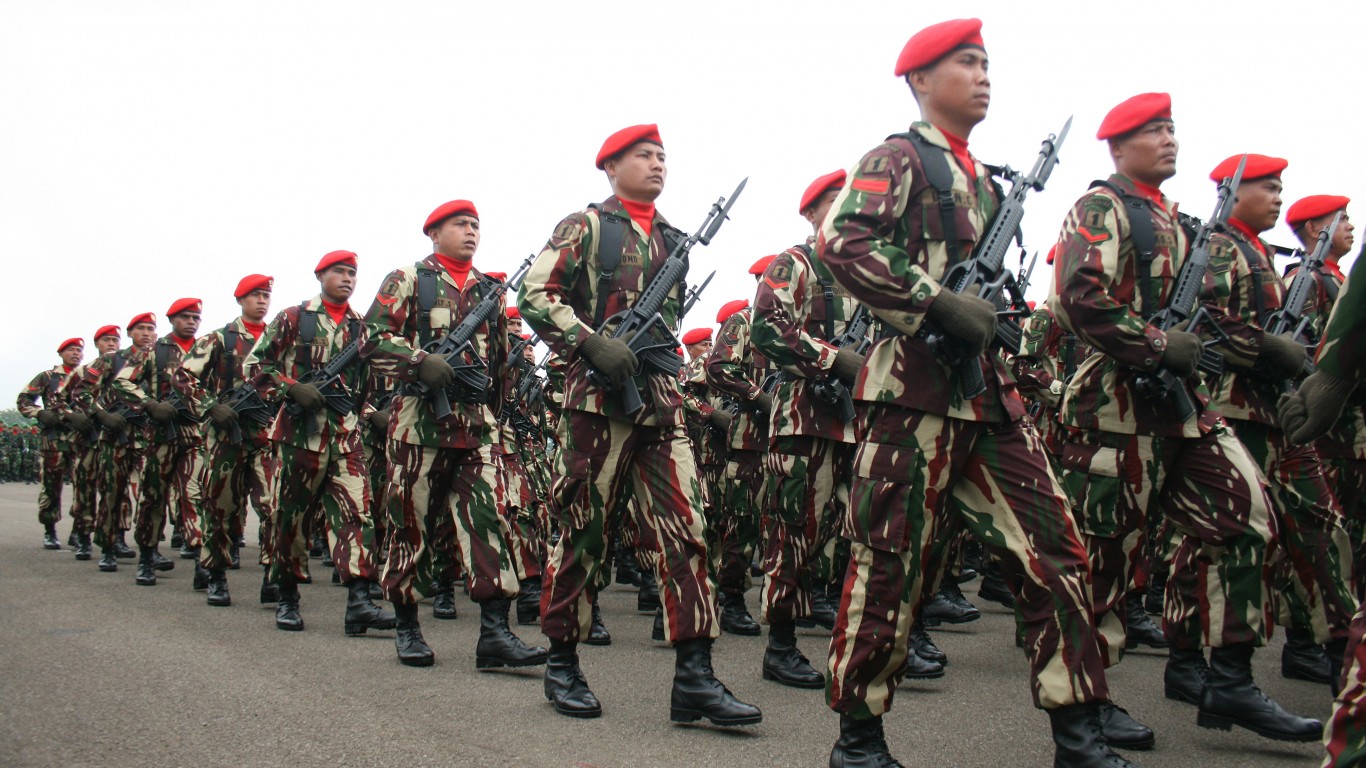
24. Indonesia
> Share of global arms imports, 2018-2022: 0.9% — tied
> Share of global arms imports, 2013-2017: 2.7%
> Largest supplier: South Korea (32% of Indonesia imports)
> 2nd largest supplier: United States (26% of Indonesia imports)
> 3rd largest supplier: France (12% of Indonesia imports)
> Annual military expenditure (2021): $8.3 billion — #28 highest of 154
> Annual military expenditure as pct. of GDP (2021): 0.7% — #130 highest of 150

23. Philippines
> Share of global arms imports, 2018-2022: 0.9% — tied
> Share of global arms imports, 2013-2017: 0.5%
> Largest supplier: South Korea (42% of Philippines imports)
> 2nd largest supplier: Israel (22% of Philippines imports)
> 3rd largest supplier: United States (15% of Philippines imports)
> Annual military expenditure (2021): $4.1 billion — #47 highest of 154
> Annual military expenditure as pct. of GDP (2021): 1% — #112 highest of 150
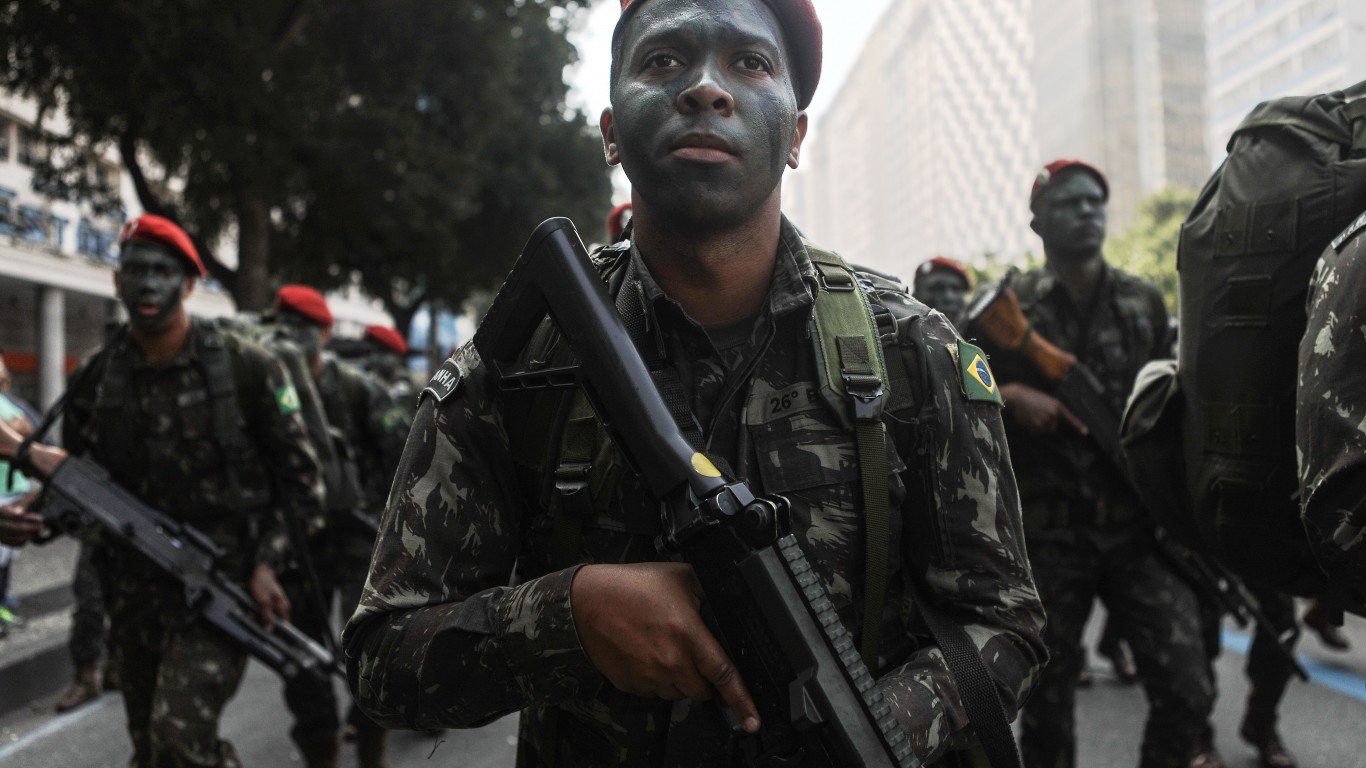
22. Brazil
> Share of global arms imports, 2018-2022: 0.9% — tied
> Share of global arms imports, 2013-2017: 0.6%
> Largest supplier: France (39% of Brazil imports)
> 2nd largest supplier: United Kingdom (14% of Brazil imports)
> 3rd largest supplier: Sweden (13% of Brazil imports)
> Annual military expenditure (2021): $19.2 billion — #17 highest of 154
> Annual military expenditure as pct. of GDP (2021): 1.2% — #102 highest of 150
[in-text-ad-2]
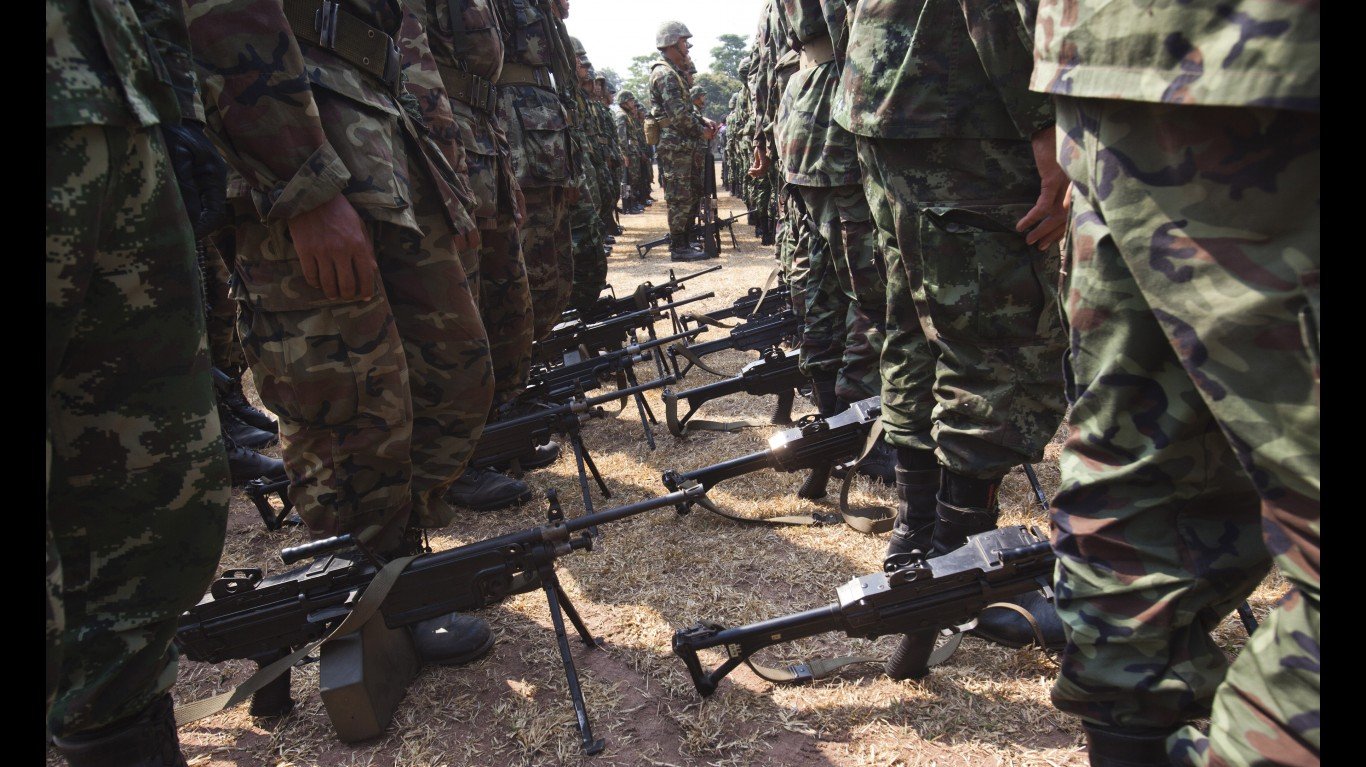
21. Thailand
> Share of global arms imports, 2018-2022: 1%
> Share of global arms imports, 2013-2017: 0.9%
> Largest supplier: South Korea (33% of Thailand imports)
> 2nd largest supplier: China (14% of Thailand imports)
> 3rd largest supplier: United States (10% of Thailand imports)
> Annual military expenditure (2021): $6.6 billion — #32 highest of 154
> Annual military expenditure as pct. of GDP (2021): 1.3% — #91 highest of 150
20. Singapore
> Share of global arms imports, 2018-2022: 1.3%
> Share of global arms imports, 2013-2017: 1.4%
> Largest supplier: France (52% of Singapore imports)
> 2nd largest supplier: United States (26% of Singapore imports)
> 3rd largest supplier: United Kingdom (7.6% of Singapore imports)
> Annual military expenditure (2021): $11.1 billion — #23 highest of 154
> Annual military expenditure as pct. of GDP (2021): 3% — #22 highest of 150
[in-text-ad]
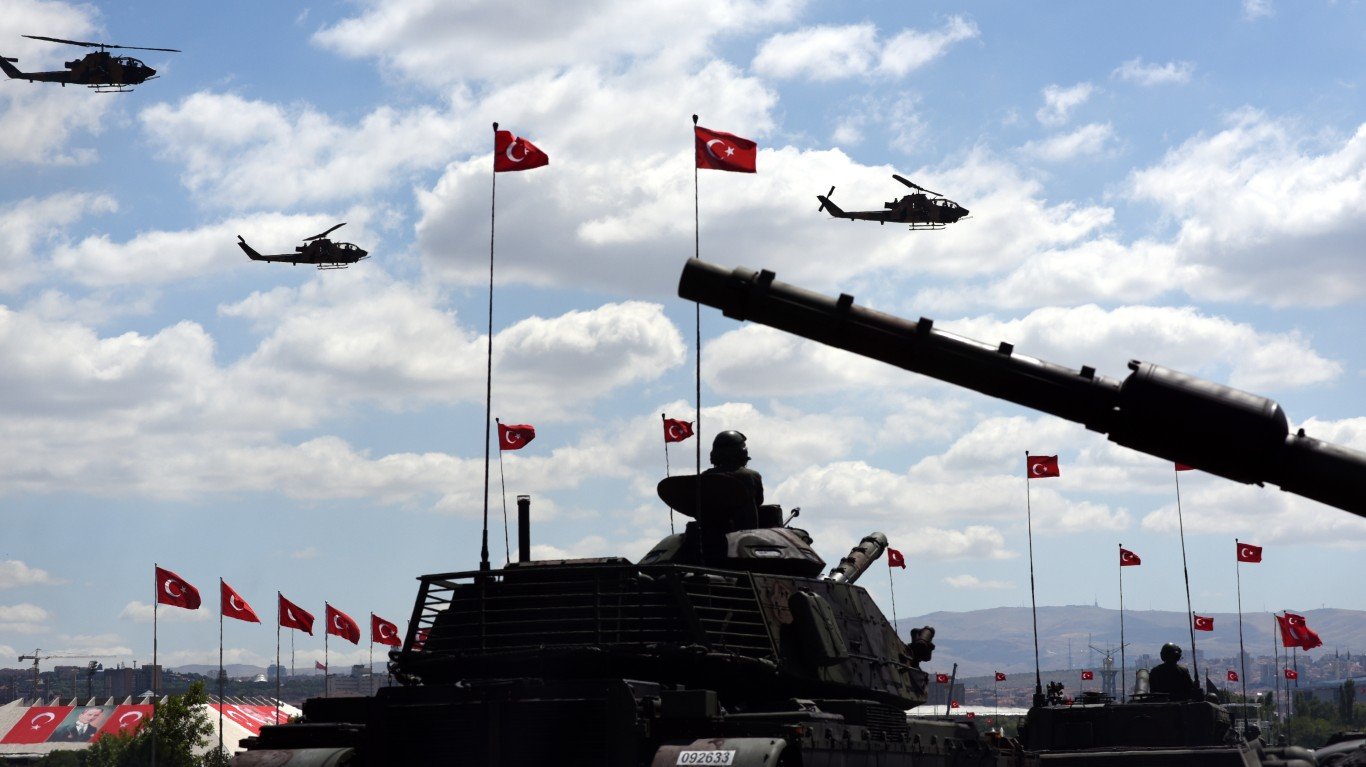
19. Turkiye
> Share of global arms imports, 2018-2022: 1.3%
> Share of global arms imports, 2013-2017: 2.4%
> Largest supplier: Italy (35% of Turkiye imports)
> 2nd largest supplier: Spain (20% of Turkiye imports)
> 3rd largest supplier: Russia (19% of Turkiye imports)
> Annual military expenditure (2021): $15.5 billion — #18 highest of 154
> Annual military expenditure as pct. of GDP (2021): 2.1% — #46 highest of 150
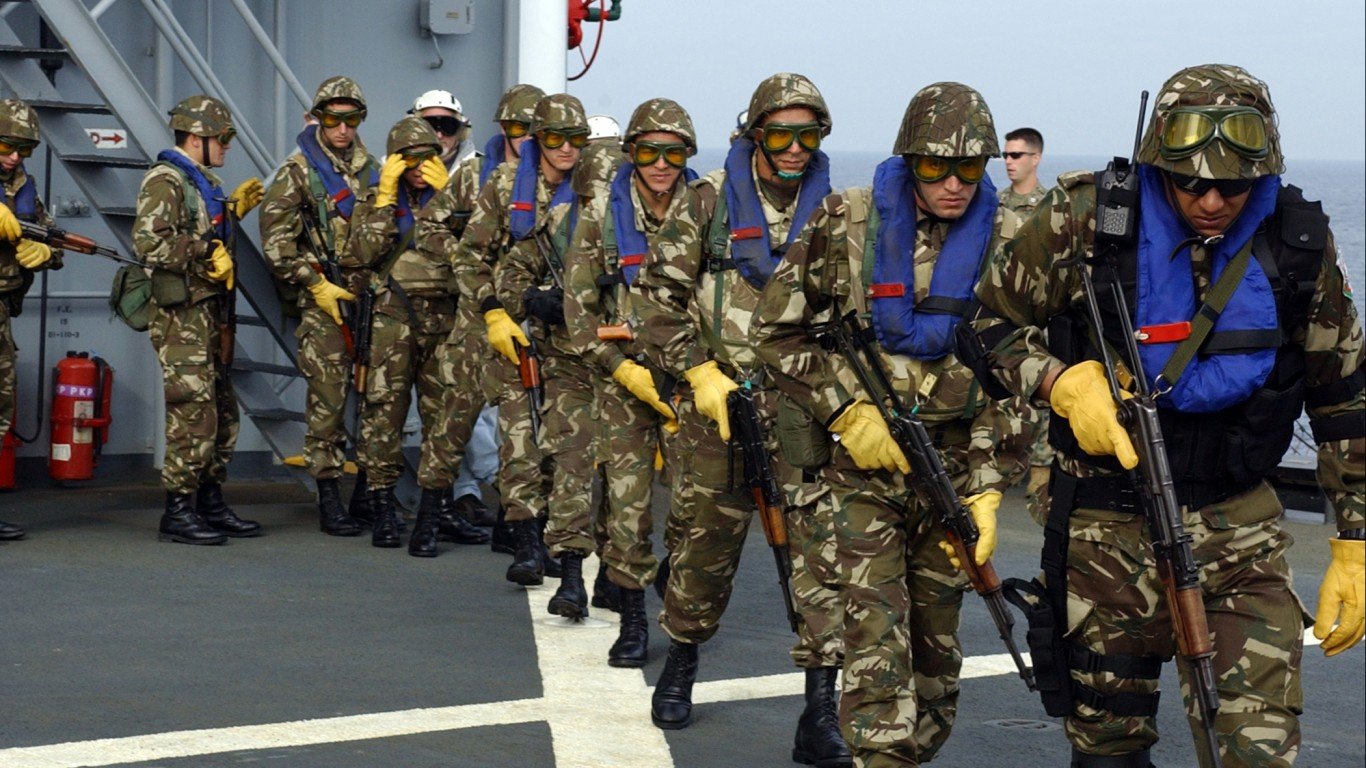
18. Algeria
> Share of global arms imports, 2018-2022: 1.8%
> Share of global arms imports, 2013-2017: 4.1%
> Largest supplier: Russia (73% of Algeria imports)
> 2nd largest supplier: Germany (10% of Algeria imports)
> 3rd largest supplier: France (5.2% of Algeria imports)
> Annual military expenditure (2021): $9.1 billion — #25 highest of 154
> Annual military expenditure as pct. of GDP (2021): 5.6% — #4 highest of 150
17. Netherlands
> Share of global arms imports, 2018-2022: 1.9%
> Share of global arms imports, 2013-2017: 0.4%
> Largest supplier: United States (95% of Netherlands imports)
> 2nd largest supplier: Germany (3.9% of Netherlands imports)
> 3rd largest supplier: Finland (0.6% of Netherlands imports)
> Annual military expenditure (2021): $13.8 billion — #19 highest of 154
> Annual military expenditure as pct. of GDP (2021): 1.4% — #82 highest of 150
[in-text-ad-2]
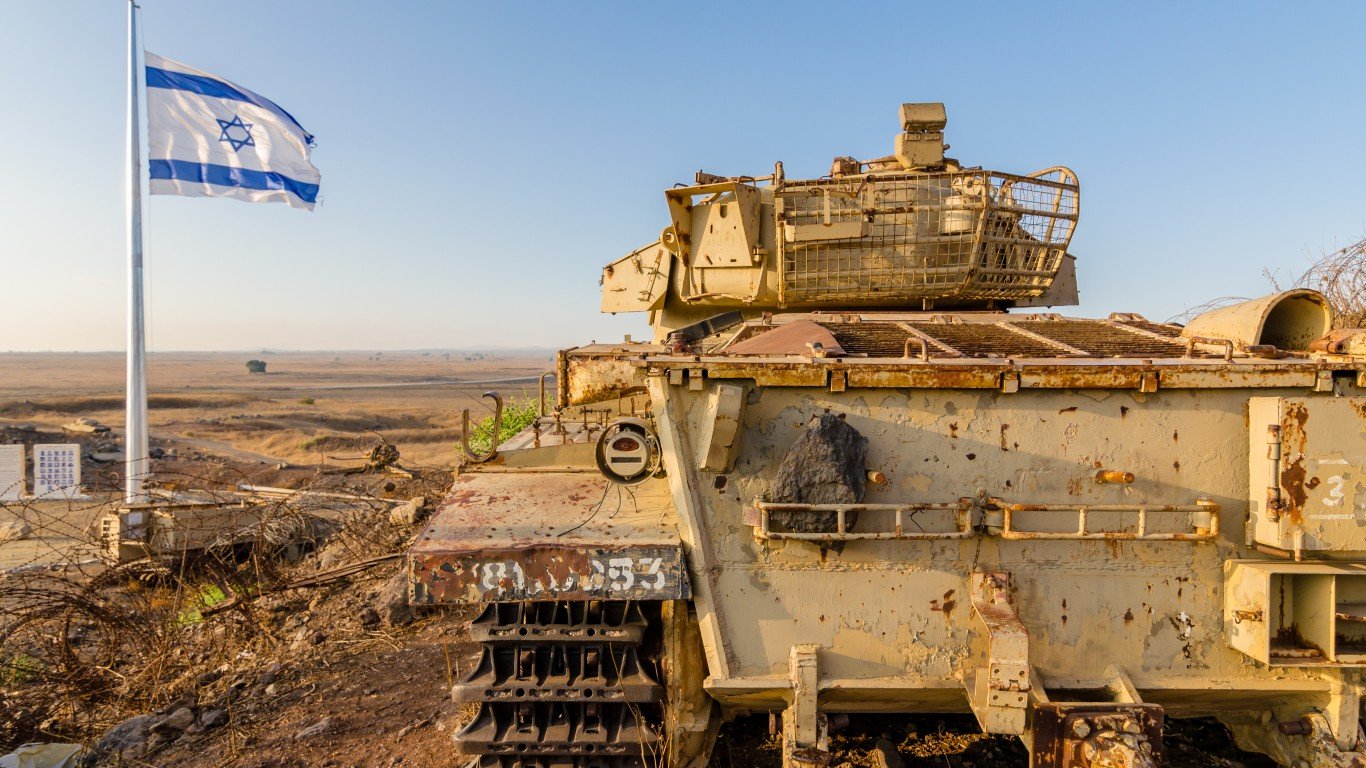
16. Israel
> Share of global arms imports, 2018-2022: 1.9%
> Share of global arms imports, 2013-2017: 1.8%
> Largest supplier: United States (79% of Israel imports)
> 2nd largest supplier: Germany (20% of Israel imports)
> 3rd largest supplier: Italy (0.2% of Israel imports)
> Annual military expenditure (2021): $24.3 billion — #15 highest of 154
> Annual military expenditure as pct. of GDP (2021): 5.2% — #6 highest of 150
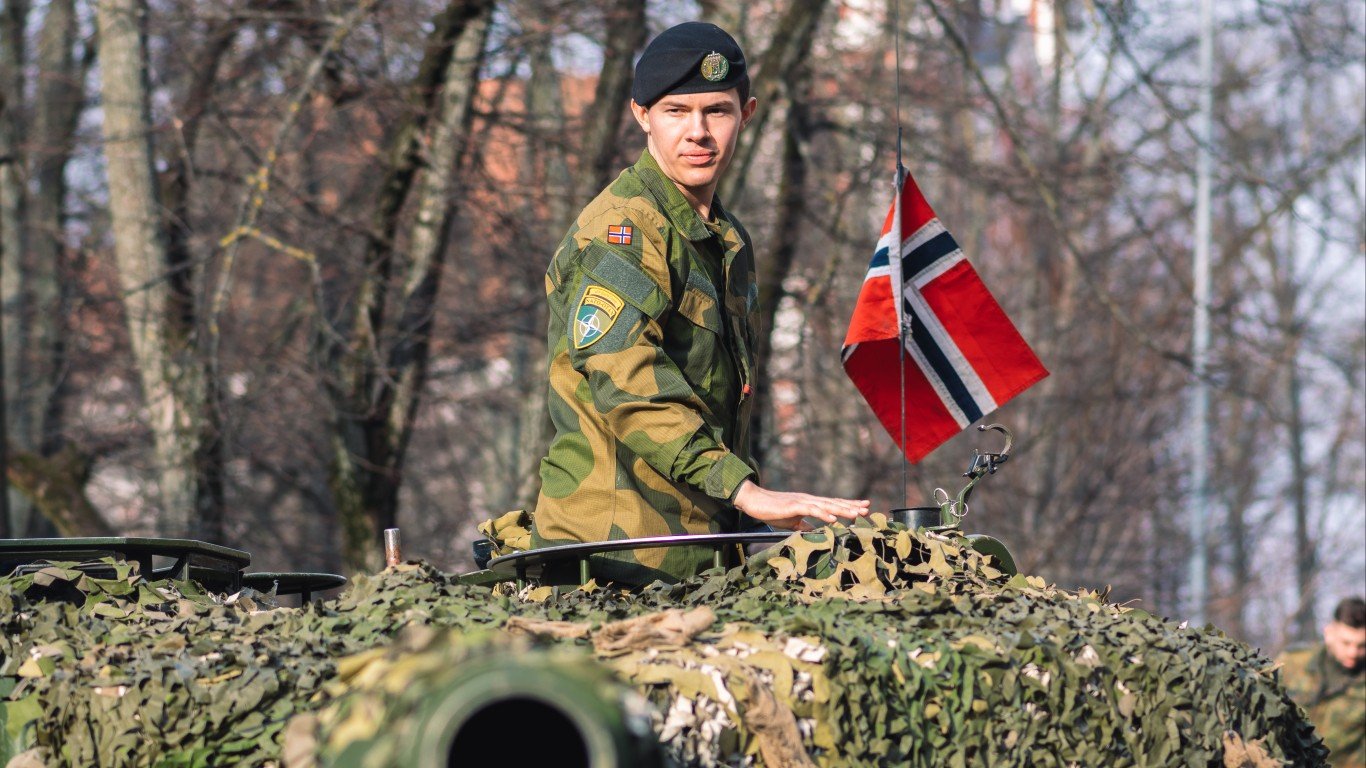
15. Norway
> Share of global arms imports, 2018-2022: 2% — tied
> Share of global arms imports, 2013-2017: 0.5%
> Largest supplier: United States (86% of Norway imports)
> 2nd largest supplier: South Korea (8.2% of Norway imports)
> 3rd largest supplier: Italy (3.5% of Norway imports)
> Annual military expenditure (2021): $8.3 billion — #29 highest of 154
> Annual military expenditure as pct. of GDP (2021): 1.8% — #59 highest of 150
[in-text-ad]
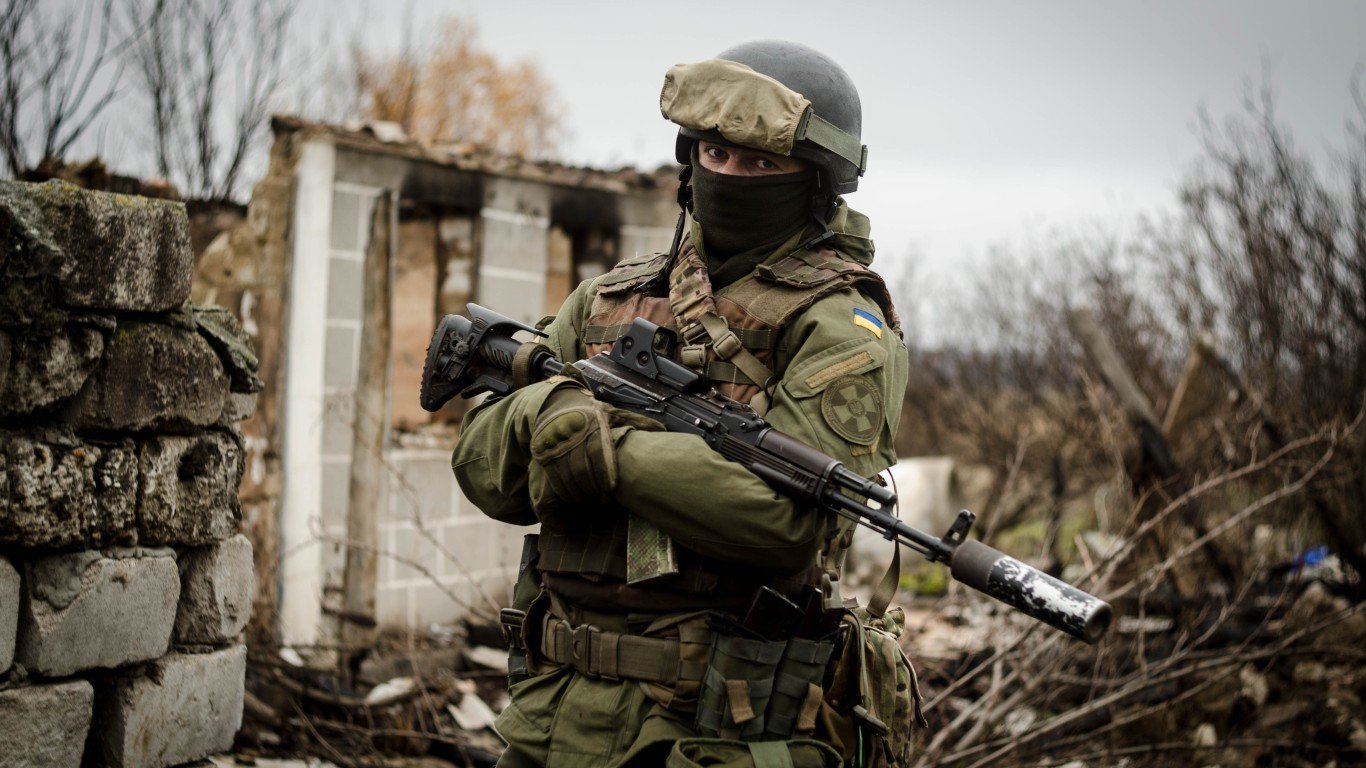
14. Ukraine
> Share of global arms imports, 2018-2022: 2% — tied
> Share of global arms imports, 2013-2017: <0.05%
> Largest supplier: United States (34% of Ukraine imports)
> 2nd largest supplier: Poland (17% of Ukraine imports)
> 3rd largest supplier: Germany (11% of Ukraine imports)
> Annual military expenditure (2021): $5.9 billion — #35 highest of 154
> Annual military expenditure as pct. of GDP (2021): 3.2% — #20 highest of 150
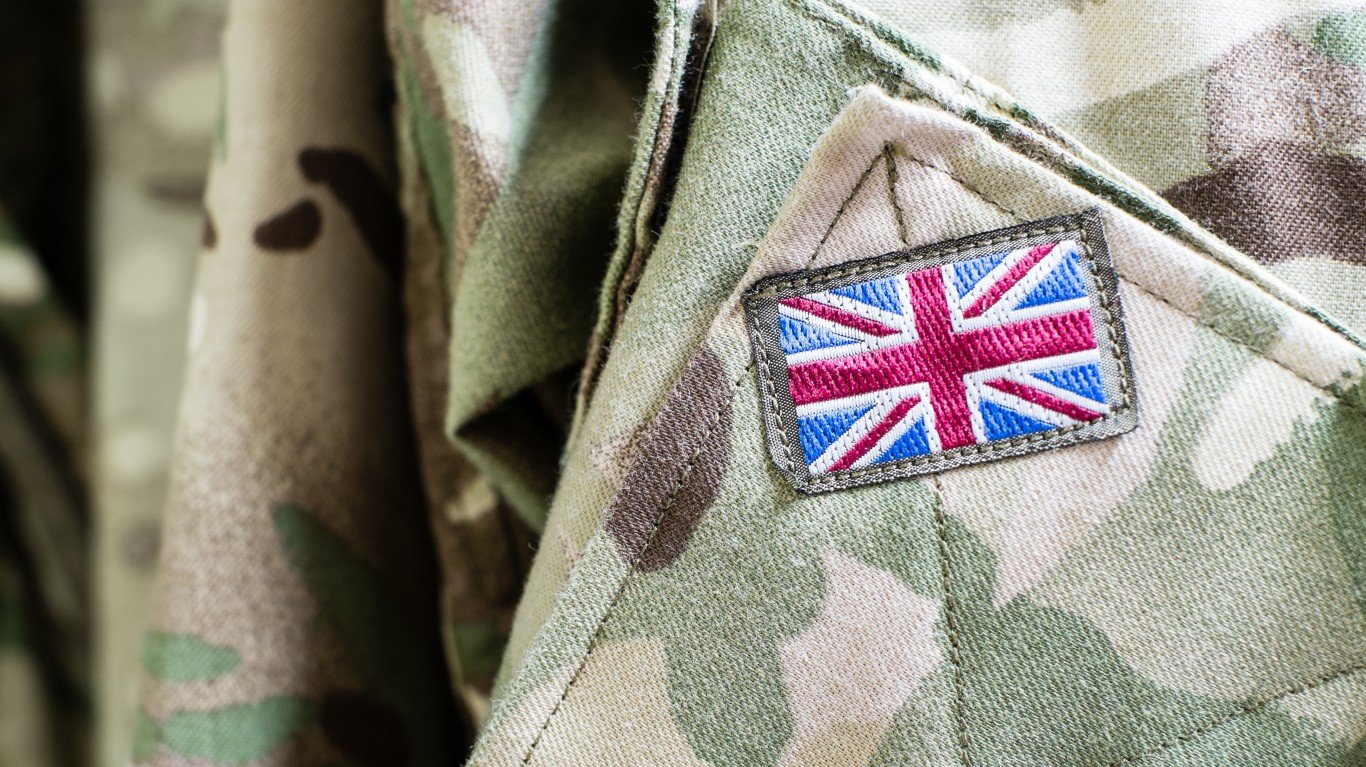
13. United Kingdom
> Share of global arms imports, 2018-2022: 2.3%
> Share of global arms imports, 2013-2017: 1.7%
> Largest supplier: United States (81% of United Kingdom imports)
> 2nd largest supplier: South Korea (13% of United Kingdom imports)
> 3rd largest supplier: Israel (2.8% of United Kingdom imports)
> Annual military expenditure (2021): $68.4 billion — #4 highest of 154
> Annual military expenditure as pct. of GDP (2021): 2.2% — #41 highest of 150
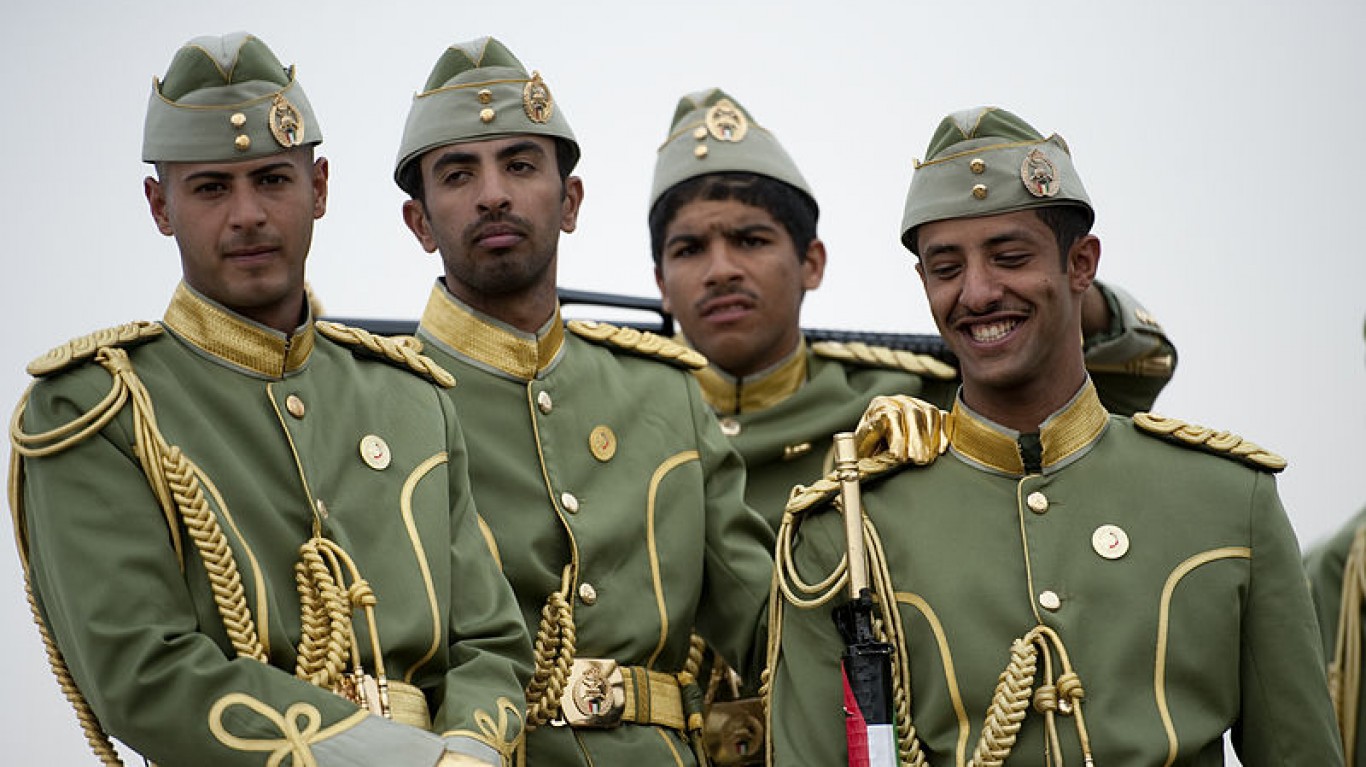
12. Kuwait
> Share of global arms imports, 2018-2022: 2.4%
> Share of global arms imports, 2013-2017: 0.9%
> Largest supplier: United States (78% of Kuwait imports)
> 2nd largest supplier: Italy (10% of Kuwait imports)
> 3rd largest supplier: France (9% of Kuwait imports)
> Annual military expenditure (2021): $9.0 billion — #26 highest of 154
> Annual military expenditure as pct. of GDP (2021): 6.7% — #2 highest of 150
[in-text-ad-2]
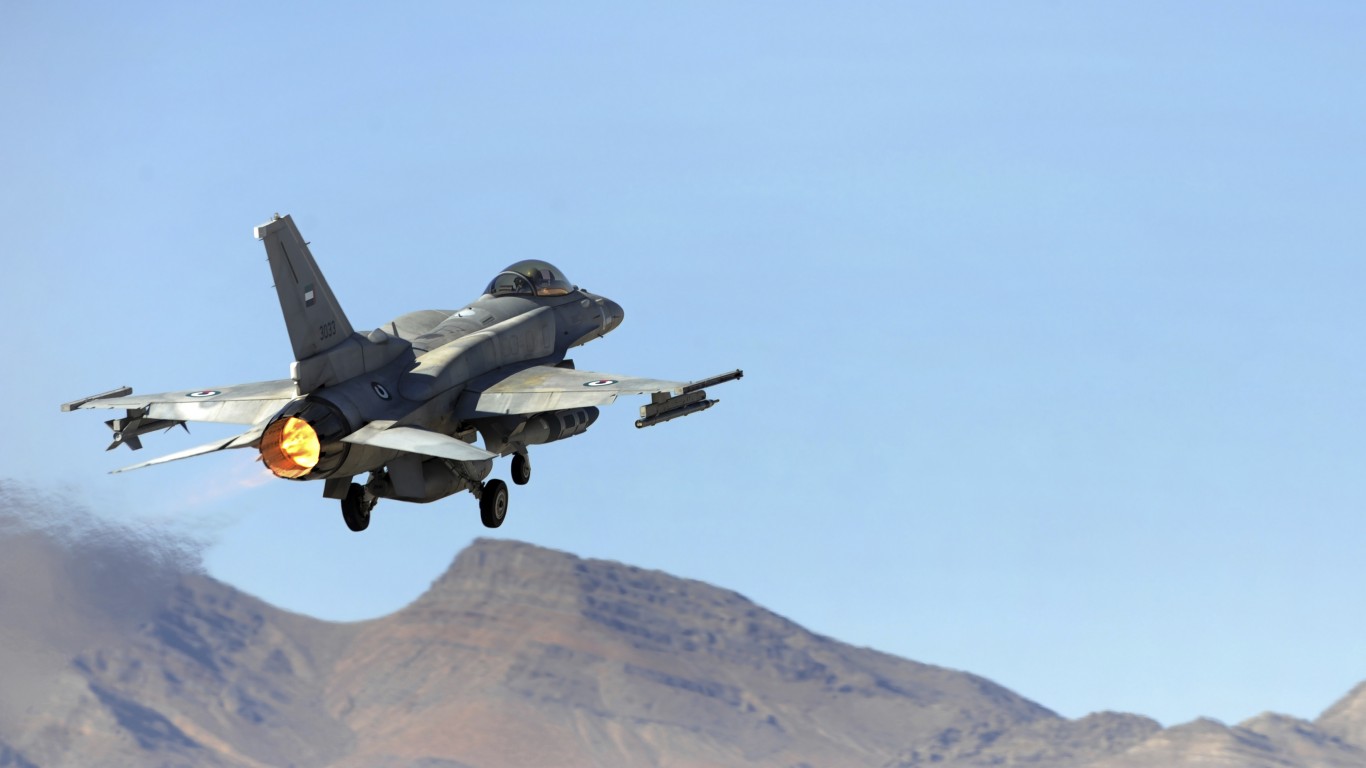
11. United Arab Emirates
> Share of global arms imports, 2018-2022: 2.7% — tied
> Share of global arms imports, 2013-2017: 4.1%
> Largest supplier: United States (66% of United Arab Emirates imports)
> 2nd largest supplier: Turkiye (7.4% of United Arab Emirates imports)
> 3rd largest supplier: Russia (5.4% of United Arab Emirates imports)
> Annual military expenditure (2021): N/A
> Annual military expenditure as pct. of GDP (2021): N/A
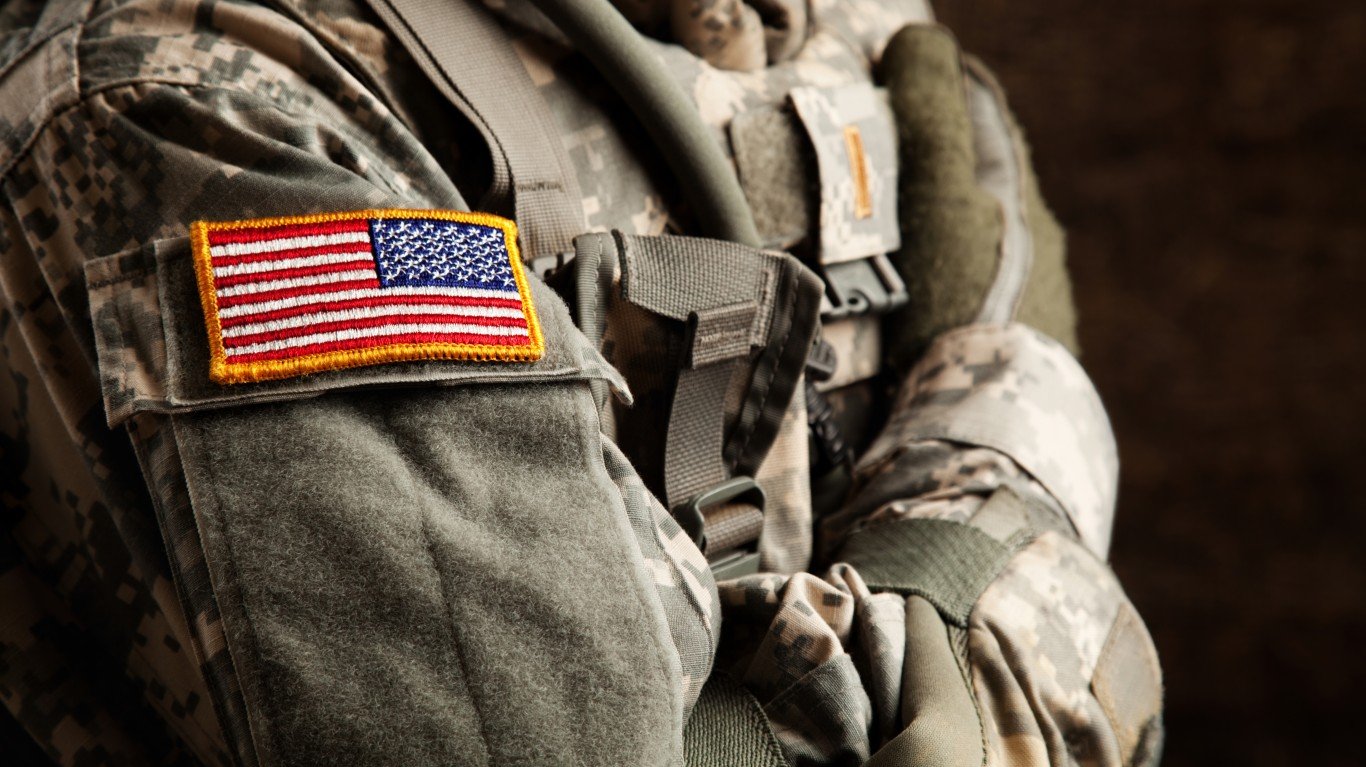
10. United States
> Share of global arms imports, 2018-2022: 2.7% — tied
> Share of global arms imports, 2013-2017: 2%
> Largest supplier: United Kingdom (24% of United States imports)
> 2nd largest supplier: Netherlands (13% of United States imports)
> 3rd largest supplier: France (11% of United States imports)
> Annual military expenditure (2021): $800.7 billion — #1 highest of 154
> Annual military expenditure as pct. of GDP (2021): 3.5% — #16 highest of 150
[in-text-ad]

9. Japan
> Share of global arms imports, 2018-2022: 3.5%
> Share of global arms imports, 2013-2017: 1.2%
> Largest supplier: United States (97% of Japan imports)
> 2nd largest supplier: United Kingdom (1.9% of Japan imports)
> 3rd largest supplier: Sweden (0.3% of Japan imports)
> Annual military expenditure (2021): $54.1 billion — #9 highest of 154
> Annual military expenditure as pct. of GDP (2021): 1.1% — #109 highest of 150
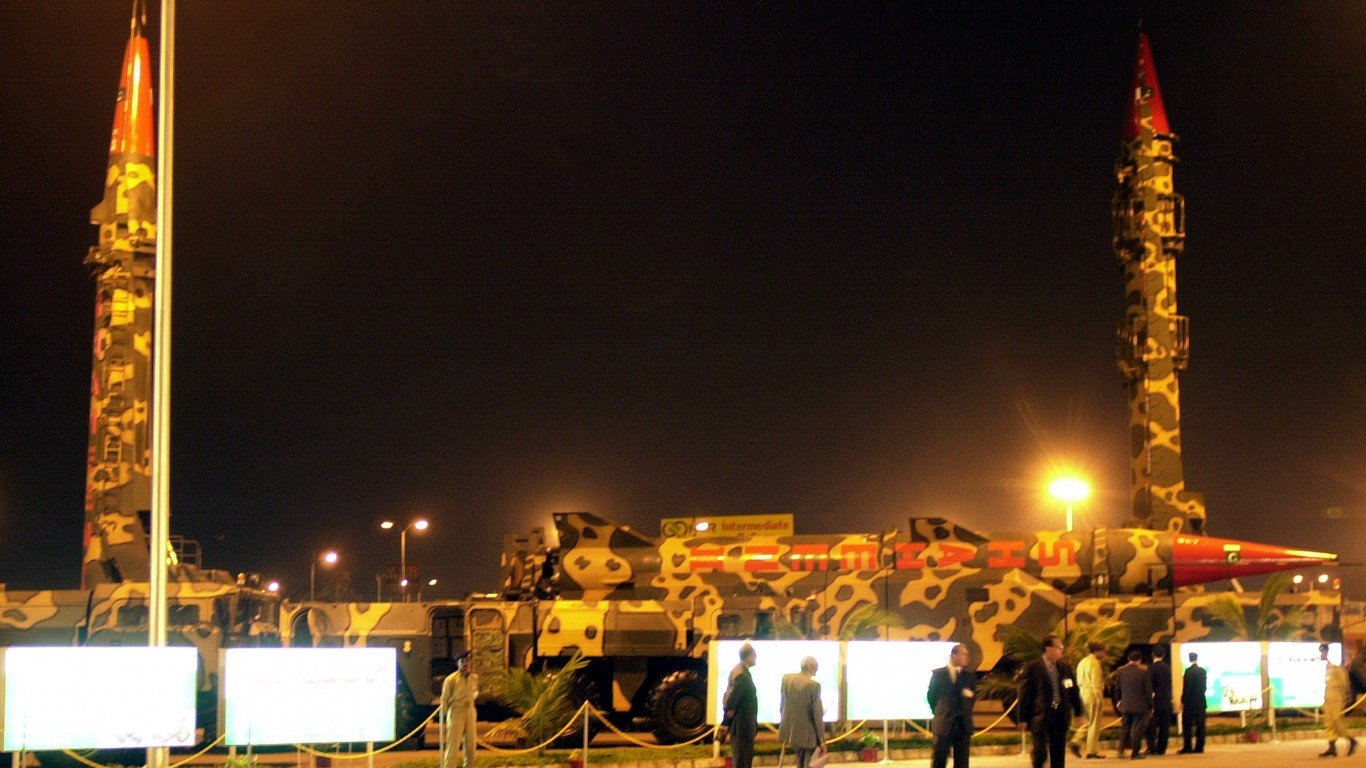
8. Pakistan
> Share of global arms imports, 2018-2022: 3.7% — tied
> Share of global arms imports, 2013-2017: 3%
> Largest supplier: China (77% of Pakistan imports)
> 2nd largest supplier: Sweden (5.1% of Pakistan imports)
> 3rd largest supplier: Russia (3.6% of Pakistan imports)
> Annual military expenditure (2021): $11.3 billion — #22 highest of 154
> Annual military expenditure as pct. of GDP (2021): 3.8% — #14 highest of 150
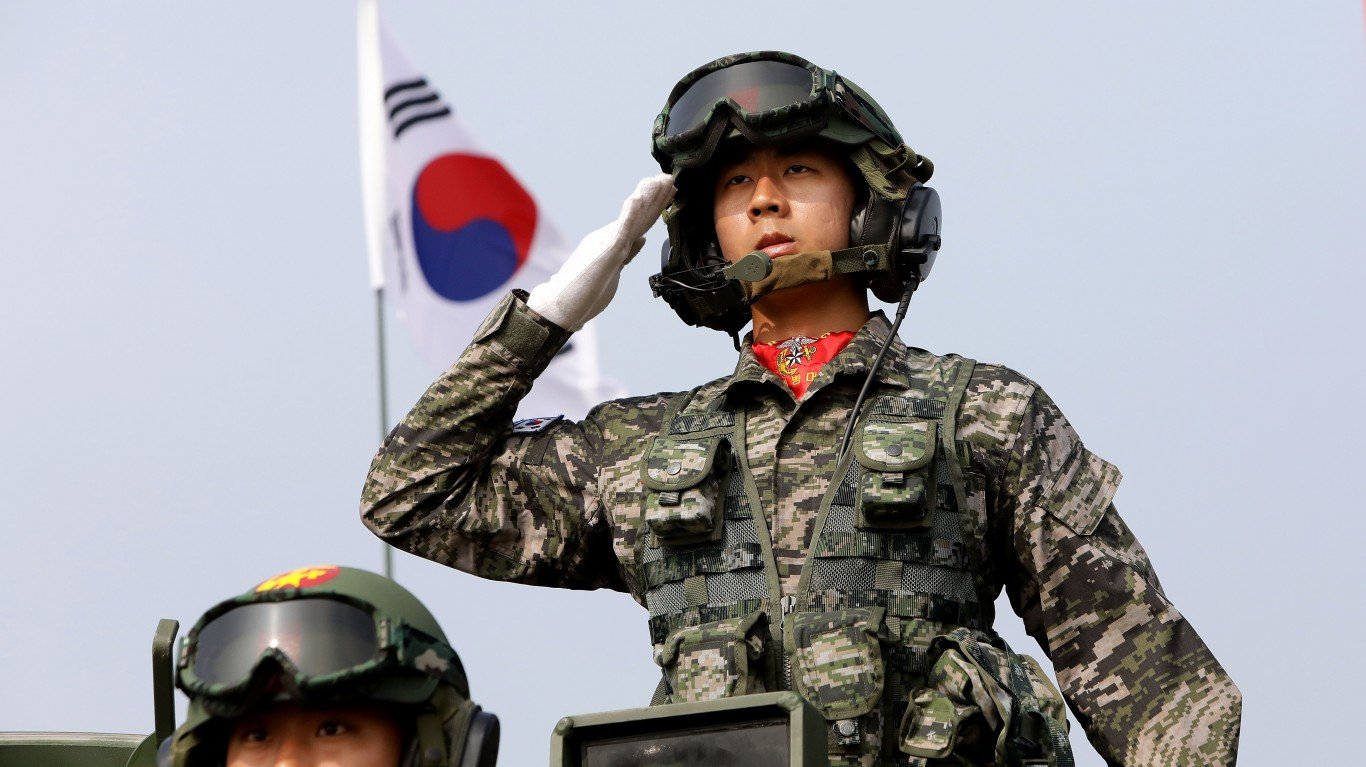
7. South Korea
> Share of global arms imports, 2018-2022: 3.7% — tied
> Share of global arms imports, 2013-2017: 2.2%
> Largest supplier: United States (71% of South Korea imports)
> 2nd largest supplier: Germany (19% of South Korea imports)
> 3rd largest supplier: France (7.9% of South Korea imports)
> Annual military expenditure (2021): $50.2 billion — #10 highest of 154
> Annual military expenditure as pct. of GDP (2021): 2.8% — #29 highest of 150
[in-text-ad-2]
6. Egypt
> Share of global arms imports, 2018-2022: 4.5%
> Share of global arms imports, 2013-2017: 4.5%
> Largest supplier: Russia (34% of Egypt imports)
> 2nd largest supplier: Italy (19% of Egypt imports)
> 3rd largest supplier: France (19% of Egypt imports)
> Annual military expenditure (2021): $5.2 billion — #42 highest of 154
> Annual military expenditure as pct. of GDP (2021): 1.3% — #95 highest of 150
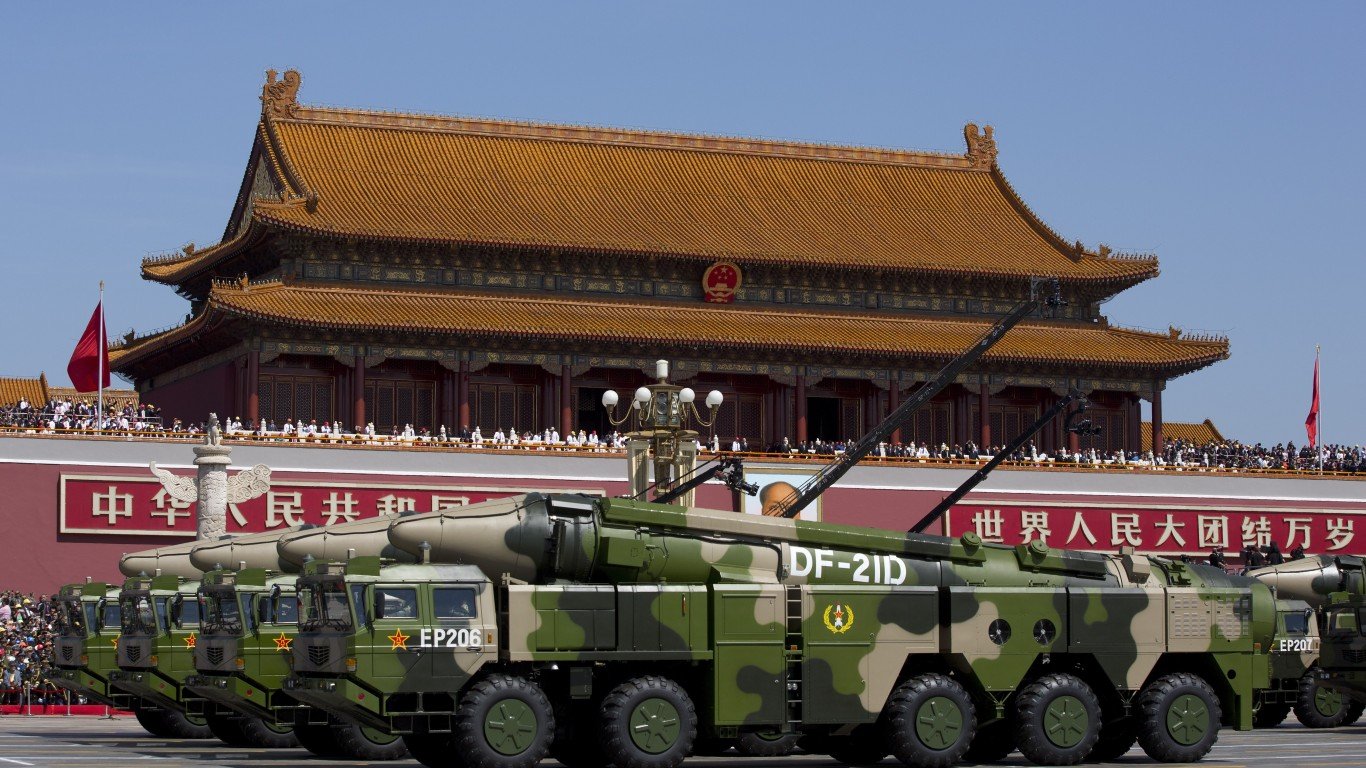
5. China
> Share of global arms imports, 2018-2022: 4.6%
> Share of global arms imports, 2013-2017: 4.2%
> Largest supplier: Russia (83% of China imports)
> 2nd largest supplier: France (8.1% of China imports)
> 3rd largest supplier: Ukraine (5.6% of China imports)
> Annual military expenditure (2021): $293.4 billion — #2 highest of 154
> Annual military expenditure as pct. of GDP (2021): 1.7% — #64 highest of 150
[in-text-ad]
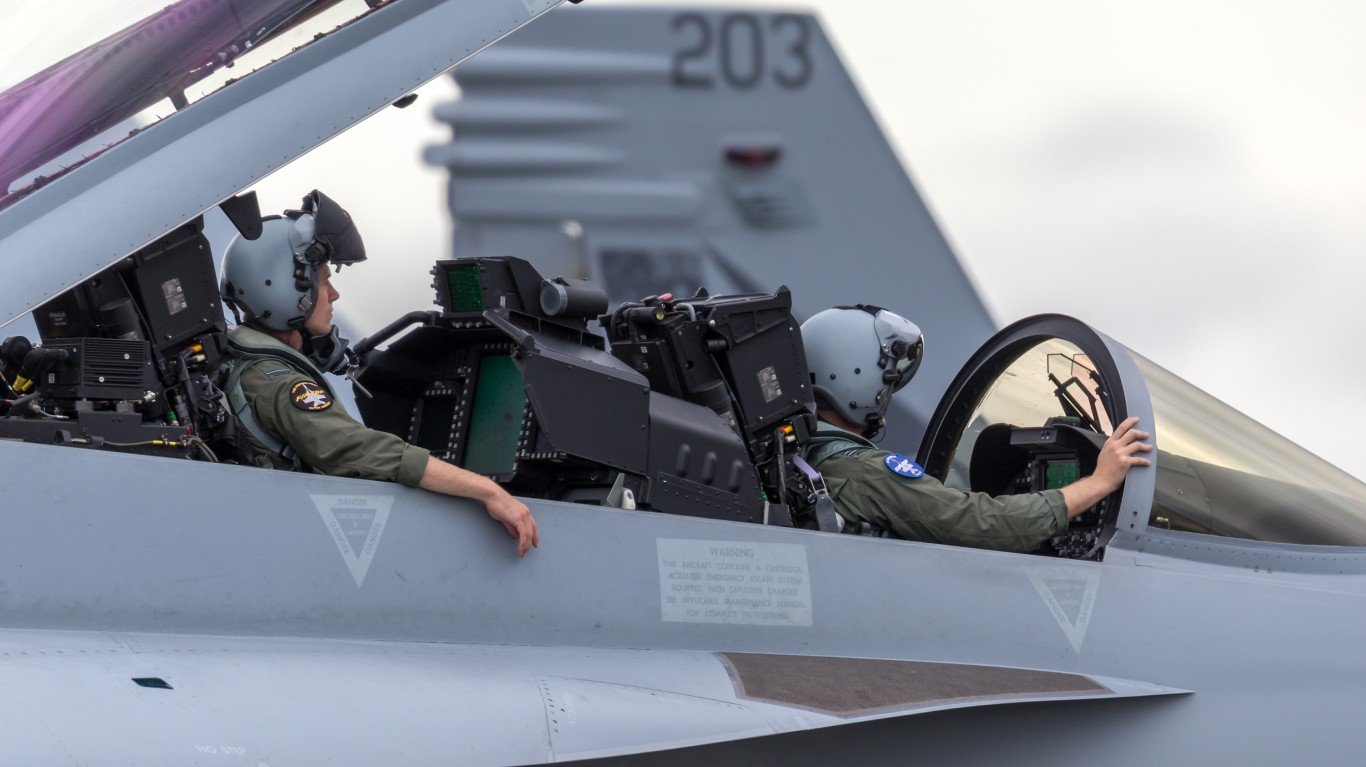
4. Australia
> Share of global arms imports, 2018-2022: 4.7%
> Share of global arms imports, 2013-2017: 3.6%
> Largest supplier: United States (73% of Australia imports)
> 2nd largest supplier: Spain (19% of Australia imports)
> 3rd largest supplier: Switzerland (3% of Australia imports)
> Annual military expenditure (2021): $31.8 billion — #12 highest of 154
> Annual military expenditure as pct. of GDP (2021): 2% — #50 highest of 150
3. Qatar
> Share of global arms imports, 2018-2022: 6.4%
> Share of global arms imports, 2013-2017: 1.5%
> Largest supplier: United States (42% of Qatar imports)
> 2nd largest supplier: France (29% of Qatar imports)
> 3rd largest supplier: Italy (14% of Qatar imports)
> Annual military expenditure (2021): $11.6 billion — #21 highest of 154
> Annual military expenditure as pct. of GDP (2021): 4.8% — #8 highest of 150
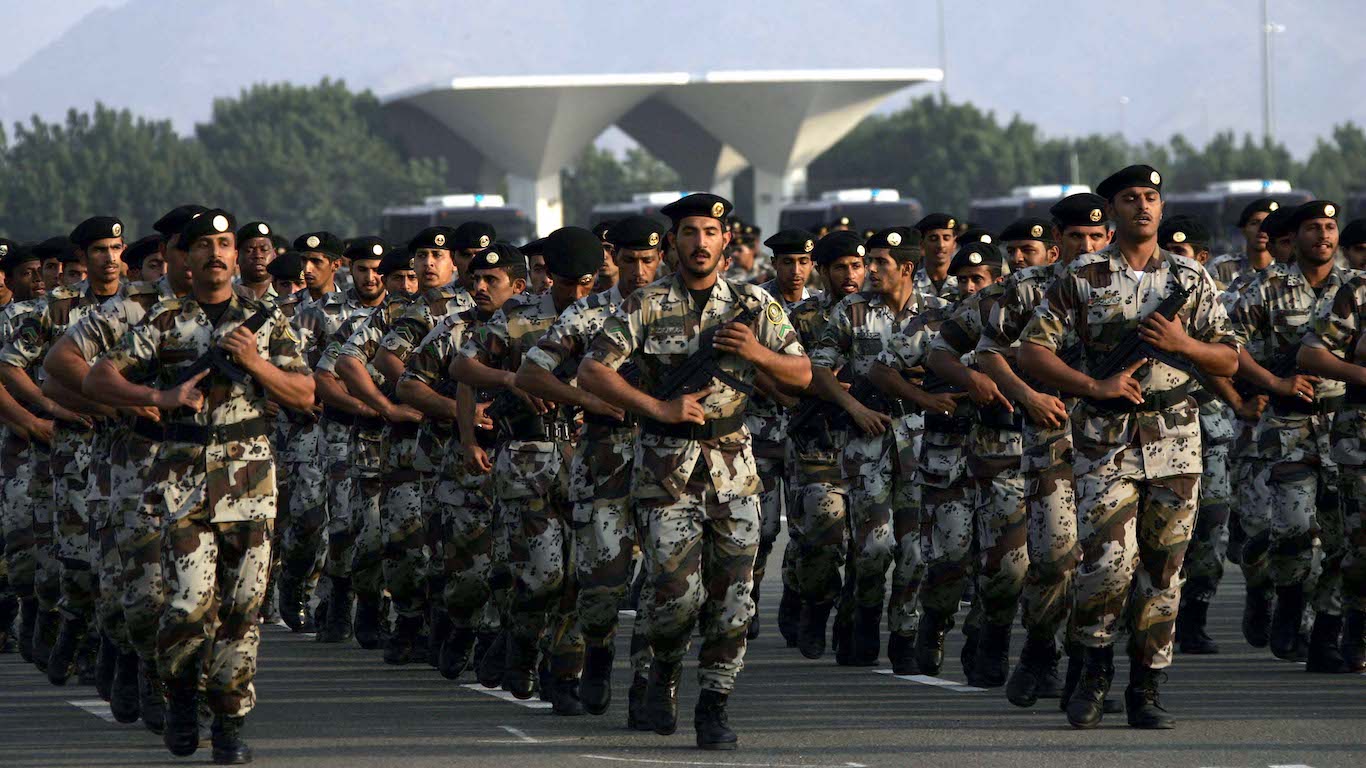
2. Saudi Arabia
> Share of global arms imports, 2018-2022: 9.6%
> Share of global arms imports, 2013-2017: 10%
> Largest supplier: United States (78% of Saudi Arabia imports)
> 2nd largest supplier: France (6.4% of Saudi Arabia imports)
> 3rd largest supplier: Spain (4.9% of Saudi Arabia imports)
> Annual military expenditure (2021): $55.6 billion — #8 highest of 154
> Annual military expenditure as pct. of GDP (2021): 6.6% — #3 highest of 150
[in-text-ad-2]
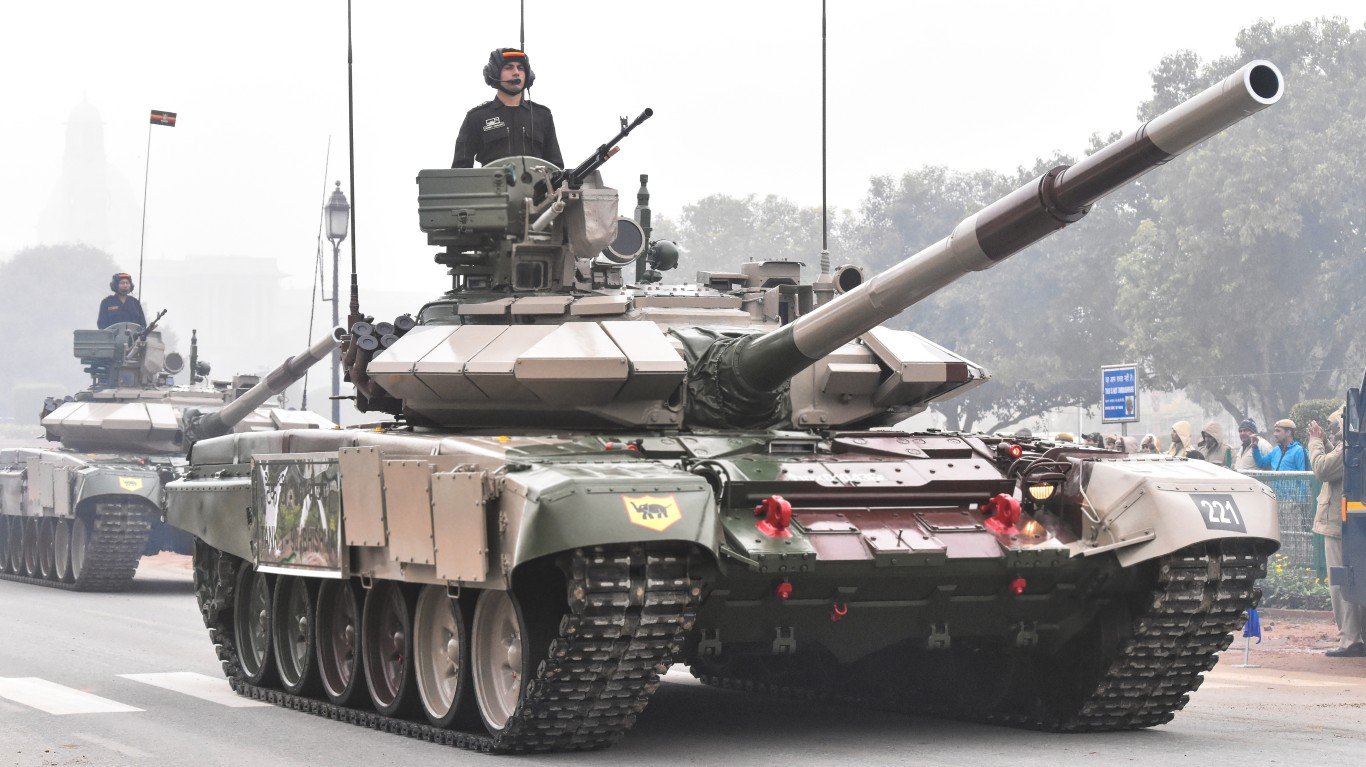
1. India
> Share of global arms imports, 2018-2022: 11%
> Share of global arms imports, 2013-2017: 12%
> Largest supplier: Russia (45% of India imports)
> 2nd largest supplier: France (29% of India imports)
> 3rd largest supplier: United States (11% of India imports)
> Annual military expenditure (2021): $76.6 billion — #3 highest of 154
> Annual military expenditure as pct. of GDP (2021): 2.7% — #31 highest of 150
Essential Tips for Investing: Sponsored
A financial advisor can help you understand the advantages and disadvantages of investment properties. Finding a qualified financial advisor doesn’t have to be hard. SmartAsset’s free tool matches you with up to three financial advisors who serve your area, and you can interview your advisor matches at no cost to decide which one is right for you. If you’re ready to find an advisor who can help you achieve your financial goals, get started now.
Investing in real estate can diversify your portfolio. But expanding your horizons may add additional costs. If you’re an investor looking to minimize expenses, consider checking out online brokerages. They often offer low investment fees, helping you maximize your profit.
Thank you for reading! Have some feedback for us?
Contact the 24/7 Wall St. editorial team.
 24/7 Wall St.
24/7 Wall St.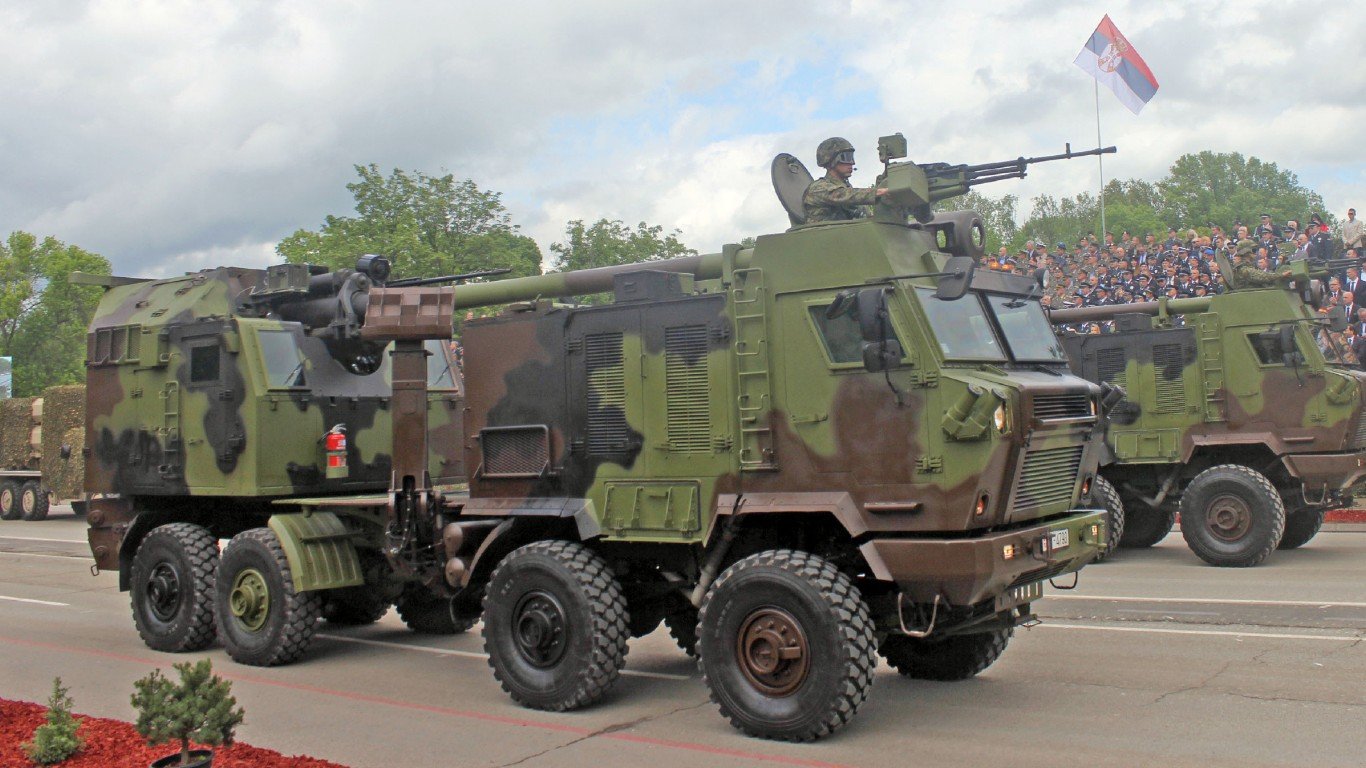
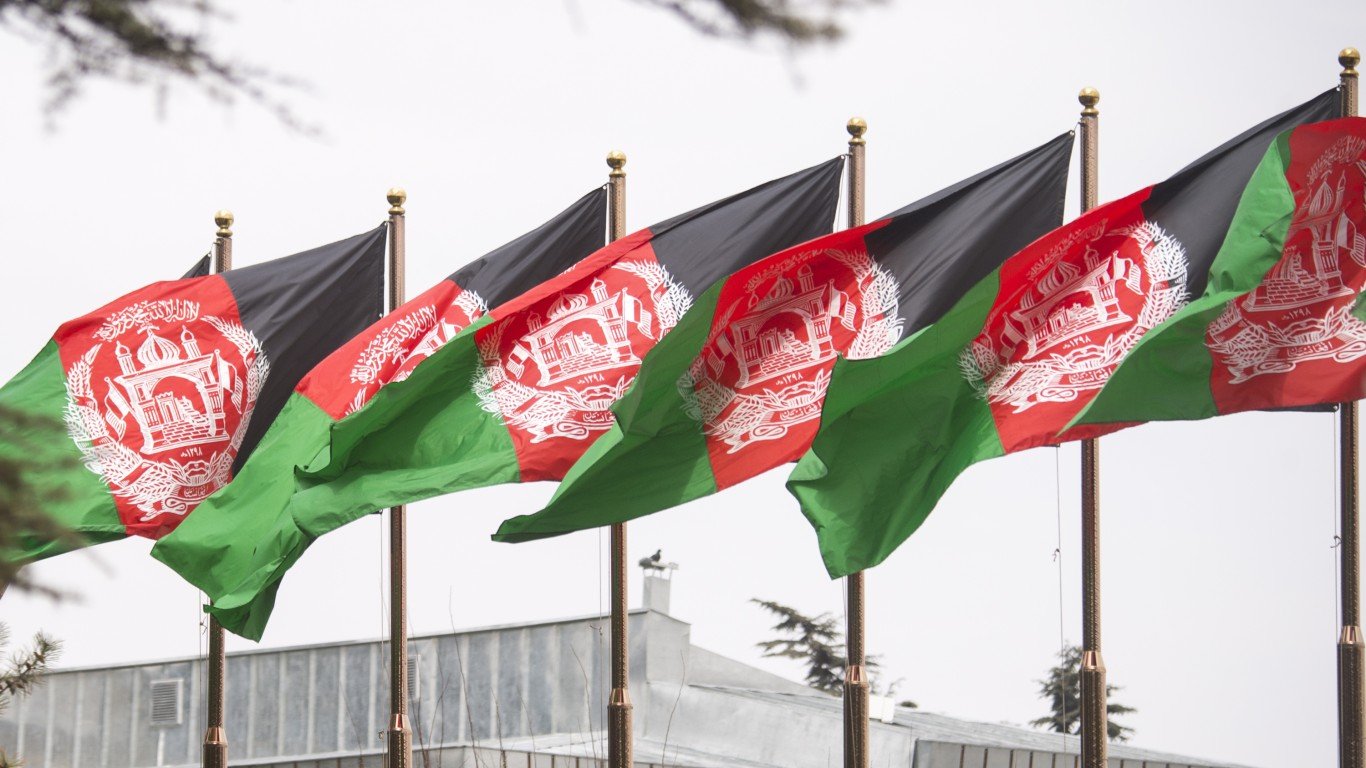
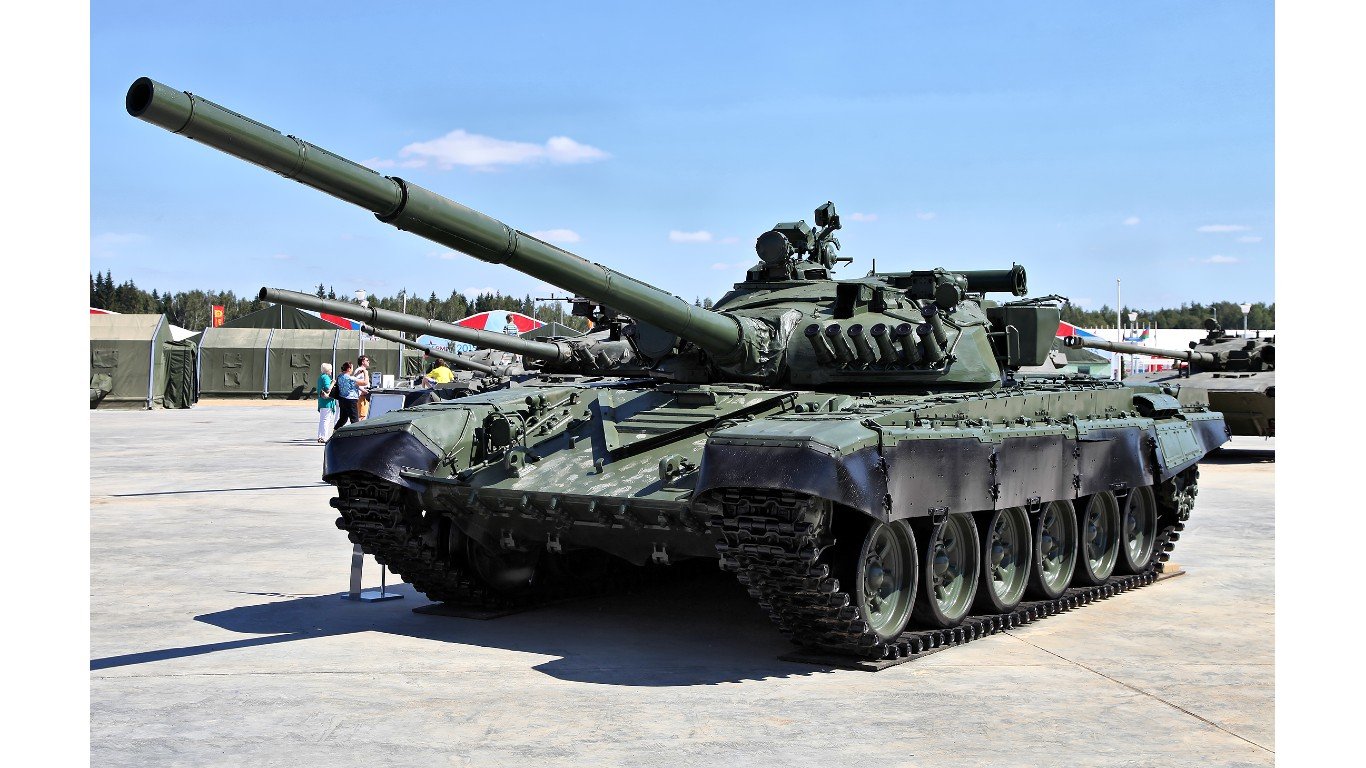


 24/7 Wall St.
24/7 Wall St.